The San Diego Zoo is a progressive zoo with over 4,000 animals of more than 800 species. The zoo offers guided tours, a Skyfari gondola lift for aerial views, and shows like the Sea Lion Show and An Avian Adventure featuring birds from around the world. The Elephant Odyssey exhibit features a 2.5-acre elephant habitat with three African and four Asian elephants, as well as other exhibits showcasing ancient Southern California species.
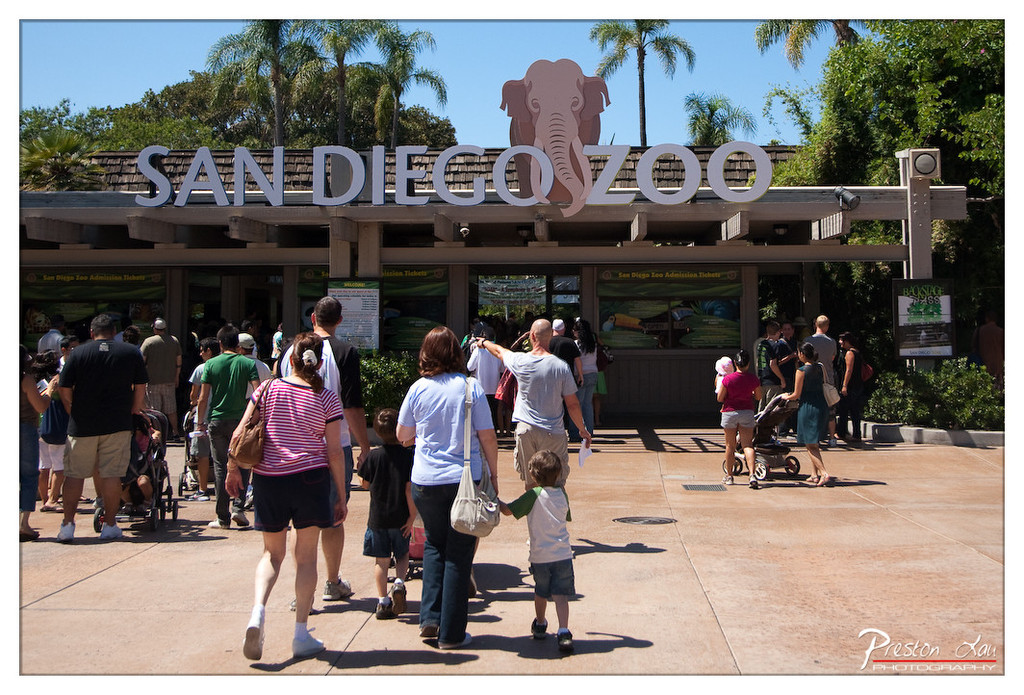

1. Overall Rating (0–10) — 7.0
This photograph captures the lively energy of a sunny day at the San Diego Zoo, where families and visitors converge under a bright blue sky. The image effectively conveys a sense of movement and anticipation, with the iconic sign serving as a strong focal point. While the composition is slightly crowded and the lighting is flat, the scene feels authentic and full of life, offering a candid glimpse into a day of shared experience.
2. Composition (0–10) — 6.5
The wide-angle perspective captures the full breadth of the entrance, but the crowd’s placement creates a somewhat uneven balance. The central path leads the eye toward the sign, though the left side feels slightly more congested, drawing attention away from the main subject.
3. Lighting (0–10) — 7.0
The bright, direct sunlight enhances clarity and color saturation, casting sharp shadows that emphasize the midday setting. However, the harsh overhead light flattens some details and creates deep contrasts, particularly in the shadows beneath the canopy.
4. Color & Tone (0–10) — 7.5
The palette is vibrant and natural, with rich greens from the palm trees, warm earth tones of the pavement, and the bright blue sky. The white signage stands out clearly, while the varied clothing colors add visual interest without overwhelming the scene.
5. Creativity (0–10) — 6.0
The image is more documentary than artistic, capturing a familiar moment with a straightforward approach. While the perspective is effective, it lacks a unique visual twist or interpretive lens that would elevate it beyond a standard travel snapshot.
6. Technical Quality (0–10) — 7.5
The focus is sharp across the frame, with fine detail visible in both the foreground and background. The exposure is well-managed despite the bright conditions, and the lens choice effectively encompasses the environment.
7. Emotional Impact (0–10) — 7.0
The photograph evokes a sense of joy and family togetherness, capturing the excitement of a shared outing. The casual interactions and relaxed pace resonate with the viewer, creating a nostalgic and relatable atmosphere.
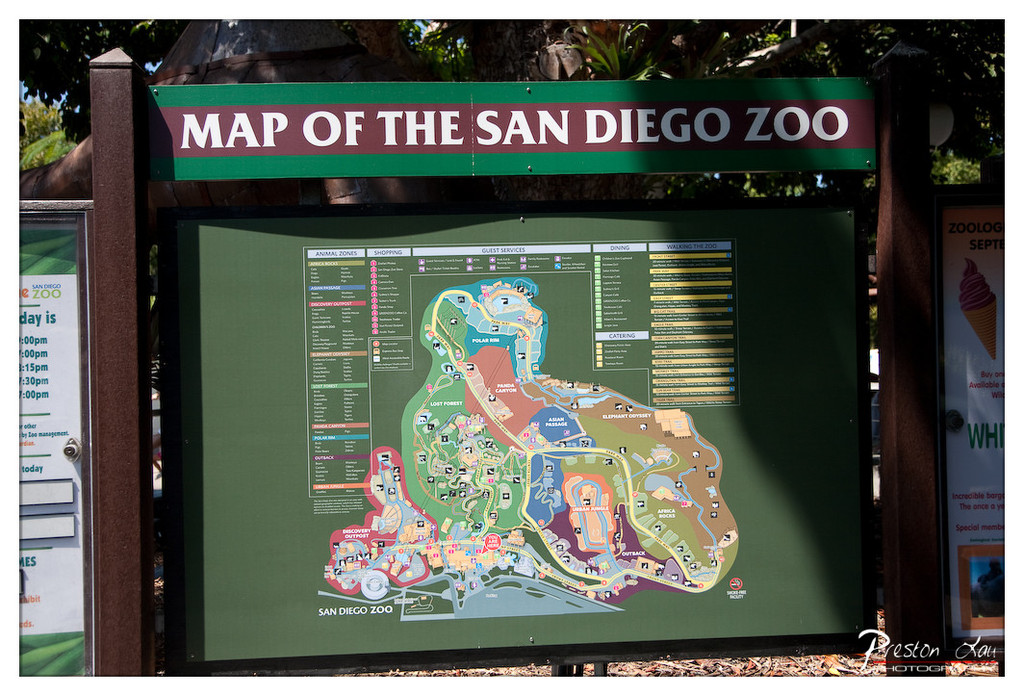

1. Overall Rating (0–10) — 6.0
This photograph captures a straightforward, functional view of the San Diego Zoo map, emphasizing clarity and information over artistic flair. The bright daylight and clean presentation make the details easily readable, but the image lacks visual dynamism, feeling more like a documentation than a composition. While the subject is inherently engaging, the execution remains flat and utilitarian, with little effort to elevate the scene into something more compelling.
2. Composition (0–10) — 6.0
The map is centered and well-framed, but the surrounding elements—signs, tree limbs, and shadows—create visual clutter that distracts from the main subject. The vertical lines of the posts and the off-center tree branch disrupt balance, slightly undermining the image’s structural harmony.
3. Lighting (0–10) — 6.5
Natural daylight provides even illumination across the map, with minimal harsh shadows. The sunlight highlights the sign’s colors and text, enhancing legibility. However, the overhead shadows from the tree canopy introduce subtle dark patches, reducing overall contrast and visual cohesion.
4. Color & Tone (0–10) — 6.0
The image features a strong, saturated green background that complements the zoo theme, but the color palette is somewhat limited and uniform. The bright, consistent tones across the map and surrounding signs create a cohesive look, though the lack of tonal variation gives the scene a flat, almost commercial feel.
5. Creativity (0–10) — 5.5
The photograph functions as a straightforward informational capture, with little artistic interpretation. While the subject matter is inherently engaging, the approach is conventional and unembellished, offering little in the way of originality or narrative depth.
6. Technical Quality (0–10) — 7.5
The image is sharp and in focus, with clear text and well-defined details on the map. The exposure is well-managed, and the resolution is high enough to allow for close inspection of the signage. There are no noticeable technical flaws, though the composition limits the overall impact.
7. Emotional Impact (0–10) — 5.0
The photograph evokes a sense of anticipation and curiosity, as it suggests a day of exploration and discovery at the zoo. However, the clinical presentation and lack of human presence or personal touch keep the emotional connection distant, making it more informative than evocative.
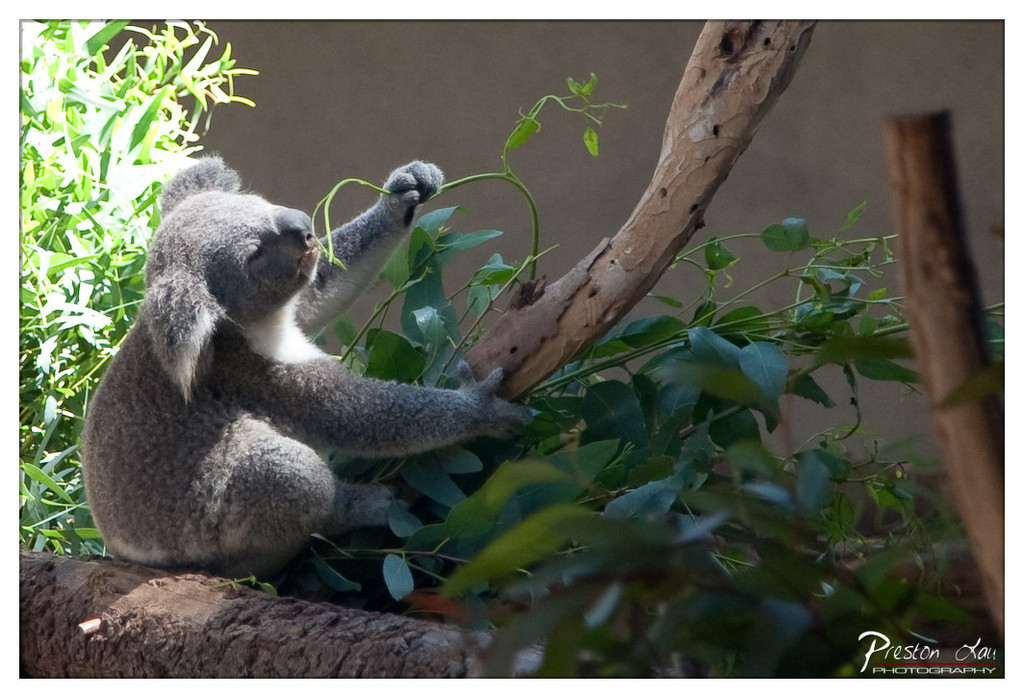

1. Overall Rating (0–10) — 7.5
This photograph captures a koala in a moment of serene natural behavior, its gentle focus on the eucalyptus branch conveying a quiet intimacy with its environment. The soft, dappled sunlight and rich textures of fur and foliage create a tactile, almost meditative atmosphere. While the image is compelling in its subject and mood, a slightly more intentional composition and lighting control could elevate it from a charming snapshot to a more powerful visual statement.
2. Composition (0–10) — 7.0
The koala is positioned slightly off-center, creating a natural focal point that draws the eye, while the diagonal branch adds dynamic tension. The foreground leaves create a subtle layering effect, though some of the foliage slightly obscures the subject, reducing clarity.
3. Lighting (0–10) — 7.5
The interplay of bright, natural light and soft shadows enhances the texture of the koala’s fur and the surrounding leaves. The backlighting on the foliage creates a gentle glow, adding depth and a sense of morning or late afternoon warmth.
4. Color & Tone (0–10) — 7.0
The green and gray palette is harmonious and true to life, with the vibrant green of the eucalyptus contrasting softly against the muted tones of the koala’s fur. The color temperature feels natural and calming, though a touch more saturation could heighten the visual impact.
5. Creativity (0–10) — 7.5
The image captures a candid, authentic moment of animal behavior, offering a quiet narrative of survival and instinct. The photographer’s choice to frame the koala mid-action—reaching, eating—adds narrative depth and a sense of life in motion.
6. Technical Quality (0–10) — 8.0
The focus is sharp on the koala’s face and paws, with fine detail visible in the fur and leaves. The depth of field is well-managed, blurring the background just enough to isolate the subject without losing environmental context.
7. Emotional Impact (0–10) — 8.0
The image evokes a sense of calm and wonder, inviting the viewer to pause and reflect on the gentle nature of the animal. The koala’s peaceful demeanor and the quiet setting foster a connection to the natural world, leaving a lingering impression of tranquility.
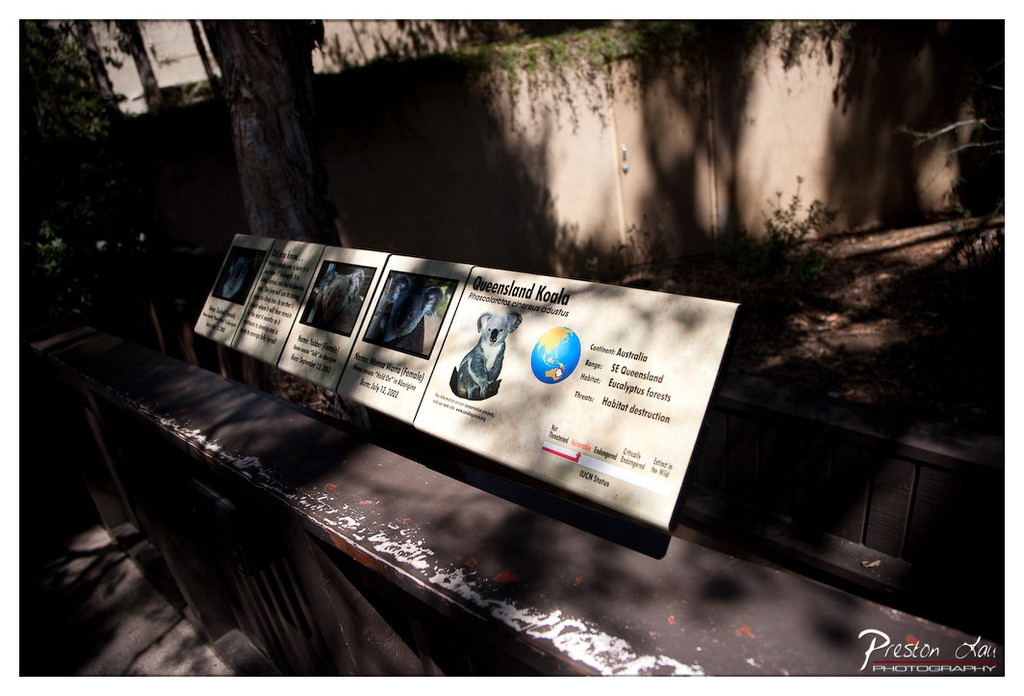

1. Overall Rating (0–10) — 6.0
This photograph captures a quiet, contemplative moment at a zoo or wildlife exhibit, where sunlight filters through trees to illuminate an informational sign about the Queensland Koala. The interplay of light and shadow adds a painterly quality, enhancing the sense of stillness and observation. While the composition and lighting create a strong mood, the image feels slightly underdeveloped in terms of clarity and visual engagement, leaving the viewer with a sense of distance rather than connection.
2. Composition (0–10) — 6.5
The sign is angled diagonally across the frame, creating a dynamic leading line, but the composition is slightly unbalanced due to the heavy shadow on the left and the cluttered background. The railing in the foreground adds depth but also distracts from the main subject.
3. Lighting (0–10) — 7.5
The dappled sunlight creates dramatic contrast and texture, highlighting the sign while casting deep shadows. The natural, directional light enhances the mood and gives the image a cinematic quality.
4. Color & Tone (0–10) — 6.0
The palette is muted and earthy, dominated by browns and grays, which suit the subject but lack vibrancy. The warm highlights on the sign provide a subtle contrast, but overall the tonal range feels somewhat flat.
5. Creativity (0–10) — 6.5
The image successfully uses natural light and framing to evoke a reflective atmosphere. The inclusion of the koala sign as a focal point suggests a narrative about conservation, though the execution remains more documentary than artistically bold.
6. Technical Quality (0–10) — 7.0
The focus is sharp on the sign, and the details are clear. However, the deep shadows in the lower portion of the frame result in some loss of detail, and the overall image could benefit from better exposure control.
7. Emotional Impact (0–10) — 5.5
The image conveys a quiet, contemplative mood, inviting reflection on wildlife and habitat loss. However, the emotional resonance is limited by the lack of a stronger focal point and the slightly detached perspective.
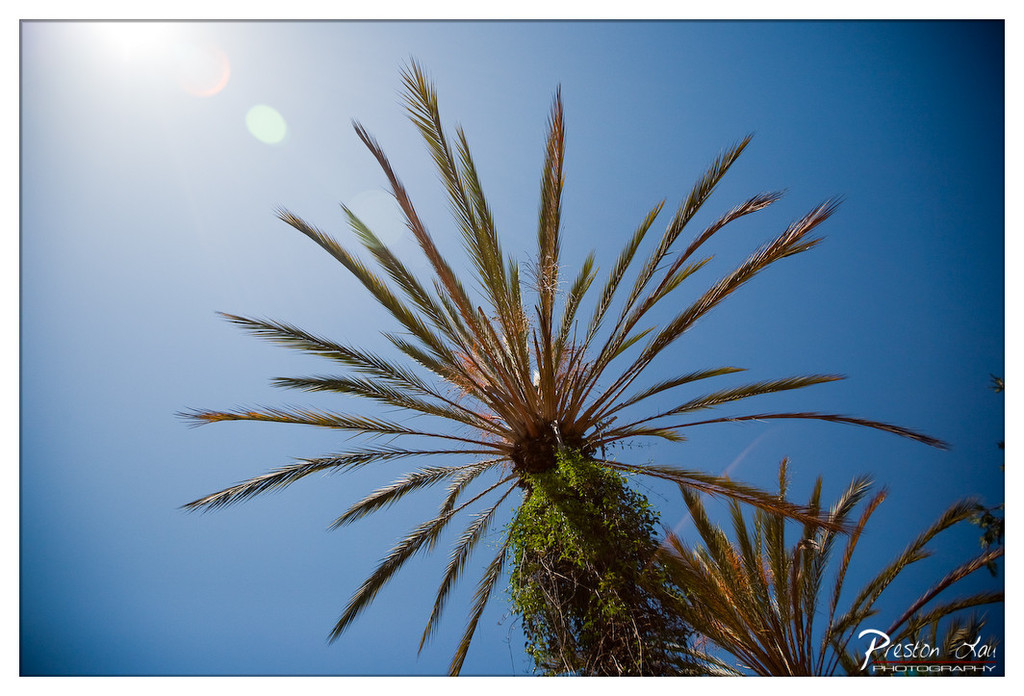

1. Overall Rating (0–10) — 7.5
This photograph captures the bold elegance of a palm tree reaching skyward, its fronds fanned dramatically against a vast, cloudless blue. The low-angle perspective emphasizes the tree’s height and vitality, while the sunburst in the upper left adds a dynamic, almost celestial glow. The image succeeds in evoking a sense of warmth and tropical serenity, though the slightly overexposed sun and harsh contrast limit its subtlety.
2. Composition (0–10) — 8.0
The low-angle view creates a powerful sense of scale, with the palm centered and its fronds radiating outward like a natural crown. The diagonal sweep of the palm fronds guides the eye dynamically, and the negative space in the upper left balances the composition well.
3. Lighting (0–10) — 7.0
The bright, direct sunlight enhances the silhouette effect and emphasizes the texture of the fronds. The lens flare adds a dreamy, sun-drenched quality, though the intense brightness in the top-left corner slightly overwhelms the frame.
4. Color & Tone (0–10) — 8.0
The deep blue sky provides a striking contrast to the golden-brown and green hues of the palm, creating a rich, warm palette. The tonal range is strong, with vivid saturation that enhances the tropical atmosphere.
5. Creativity (0–10) — 7.5
The choice of perspective and the interplay between light and silhouette lend the image a bold, almost sculptural quality. The inclusion of the lens flare adds an intentional touch of visual poetry, elevating it beyond a simple landscape shot.
6. Technical Quality (0–10) — 8.5
The image is sharp, with clear detail in the palm fronds and a clean, well-defined focus. The exposure is handled well overall, though the sun’s overexposure suggests a slight loss in highlight detail.
7. Emotional Impact (0–10) — 8.0
The photograph evokes a strong sense of warmth, freedom, and natural beauty, transporting the viewer to a sunny, peaceful moment in a tropical setting. The radiant composition inspires a feeling of awe and tranquility.
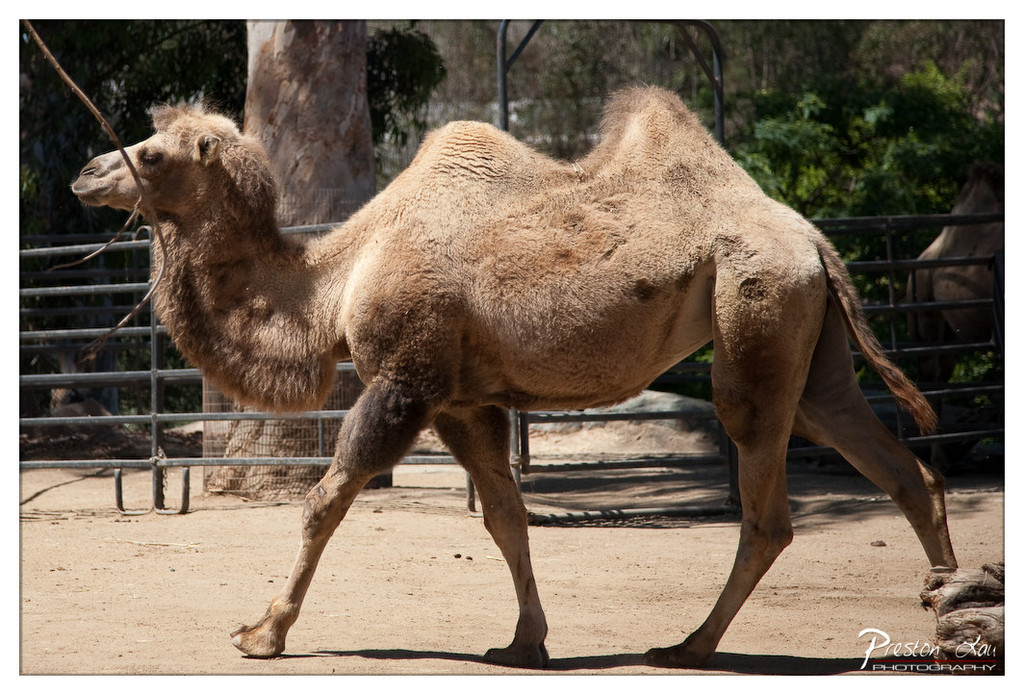

1. Overall Rating (0–10) — 6.8
This photograph captures a camel in motion within a zoo enclosure, conveying a sense of natural grace despite its constrained environment. The camel’s posture and forward stride create a dynamic flow, while the sunlit setting emphasizes texture and form. However, the composition feels slightly unbalanced, and the background clutter detracts from the subject’s elegance, holding the image back from greater visual impact.
2. Composition (0–10) — 6.0
The camel is framed off-center, creating a sense of movement, but the uneven placement and visible fencing reduce visual harmony. A tighter crop would better focus attention on the animal’s form.
3. Lighting (0–10) — 7.5
Bright, direct sunlight enhances the camel’s textured fur and casts a clear shadow, giving the image depth and dimension. The high contrast highlights form but also introduces some overexposed areas in the background.
4. Color & Tone (0–10) — 7.0
The warm, earthy tones of the camel and enclosure ground the image in a natural palette. While the colors are true to life, they lack vibrancy, resulting in a somewhat muted overall impression.
5. Creativity (0–10) — 6.5
The image captures a candid moment of animal behavior, offering a realistic glimpse into a zoo setting. While the concept is straightforward, the emphasis on motion and texture adds a layer of observational interest.
6. Technical Quality (0–10) — 8.0
The photograph is sharp, with clear focus on the camel and good detail in the fur and limbs. The exposure is well-managed despite the challenging lighting conditions.
7. Emotional Impact (0–10) — 6.0
The image evokes a quiet sense of observation, but the institutional setting and lack of emotional context limit its ability to connect deeply with the viewer. The camel’s calm movement offers a subtle moment of dignity, but it remains restrained.
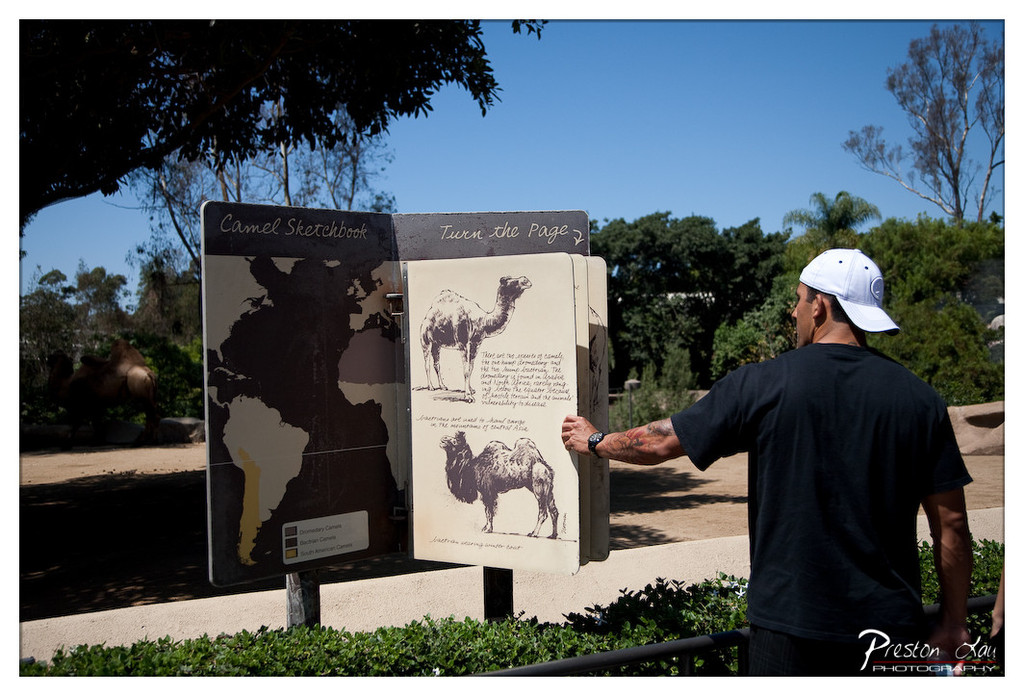

1. Overall Rating (0–10) — 7.0
This photograph captures a candid moment of engagement at a zoo exhibit, where a visitor interacts with an educational display titled "Camel Sketchbook." The juxtaposition of the man turning a page—revealing hand-drawn camels—against the real camel in the background creates a layered narrative about learning and observation. While the image effectively conveys a sense of curiosity and place, the composition feels slightly unbalanced, and the lighting, though bright, lacks subtlety in rendering depth.
2. Composition (0–10) — 6.0
The subject is placed off-center, creating a dynamic but slightly uneven frame. The open display dominates the left side, while the man and background elements extend into the right, creating visual tension. A tighter crop could improve focus and balance.
3. Lighting (0–10) — 7.5
Strong, direct sunlight enhances contrast and defines the scene with clarity. The bright blue sky and sharp shadows lend energy to the image, though the harsh overhead light slightly flattens some details in the midtones.
4. Color & Tone (0–10) — 6.5
The palette is dominated by warm earth tones and deep greens, complemented by the bright blue sky. While the colors are natural and cohesive, the vibrancy is restrained, giving the image a slightly muted, documentary feel.
5. Creativity (0–10) — 7.0
The concept of connecting a hand-drawn sketchbook with a real camel in the same environment is imaginative and conceptually strong. It invites reflection on representation versus reality, lending a subtle narrative depth.
6. Technical Quality (0–10) — 7.5
The image is sharp and well-focused, particularly on the man’s arm and the sketchbook. The depth of field is appropriate, and there are no visible technical flaws in exposure or focus.
7. Emotional Impact (0–10) — 6.5
The photograph evokes a sense of quiet discovery and curiosity, inviting the viewer to consider the act of learning in public spaces. While the emotional resonance is present, it remains subdued due to the candid, observational nature of the moment.
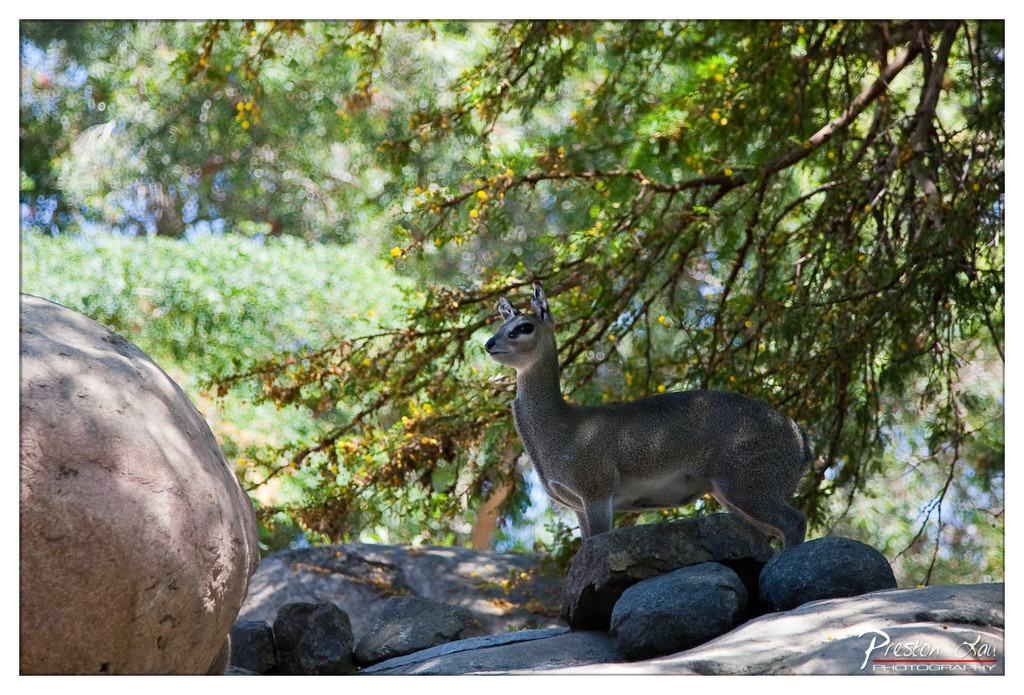

1. Overall Rating (0–10) — 7.0
This photograph captures a serene moment in nature, where a small antelope stands alert atop a rocky outcrop beneath a leafy canopy. The interplay of light and shadow enhances the animal’s delicate form, creating a sense of quiet observation. While the image is well-composed and rich in natural detail, the slightly overexposed highlights in the background detract from the overall subtlety and depth of the scene.
2. Composition (0–10) — 7.5
The subject is well-placed along the right third of the frame, creating a balanced visual flow with the large rock on the left. The diagonal line of the tree branches adds dynamism, guiding the eye toward the animal. The depth of field effectively isolates the subject, though the foreground rock slightly dominates the frame.
3. Lighting (0–10) — 7.0
Natural sunlight filters through the canopy, casting soft dappled light across the scene. The highlights on the animal’s back and the bright background foliage create a gentle contrast, though some areas are slightly overexposed, losing detail in the highlights.
4. Color & Tone (0–10) — 7.5
The palette is rich with earthy greens and grays, reflecting the natural habitat. The contrast between the warm tones of the rock and the cooler shadows enhances the image’s depth. A slightly cooler white balance gives the scene a crisp, clean feel without appearing unnatural.
5. Creativity (0–10) — 7.0
The photograph captures a quiet, intimate moment in the wild with a sense of stillness and observation. The choice to frame the animal within the foliage and rock adds narrative depth, suggesting a moment of vigilance or contemplation in its natural environment.
6. Technical Quality (0–10) — 8.0
The image is sharp and well-focused on the animal, with clean detail in the fur and surrounding textures. The depth of field is appropriately controlled, and the exposure is generally balanced, though minor overexposure in the background reduces overall tonal range.
7. Emotional Impact (0–10) — 7.5
The image evokes a sense of calm and wonder, inviting the viewer to pause and reflect on the quiet beauty of wildlife. The animal’s alert posture and the peaceful setting create a subtle tension between vulnerability and awareness, fostering a strong emotional connection to the natural world.
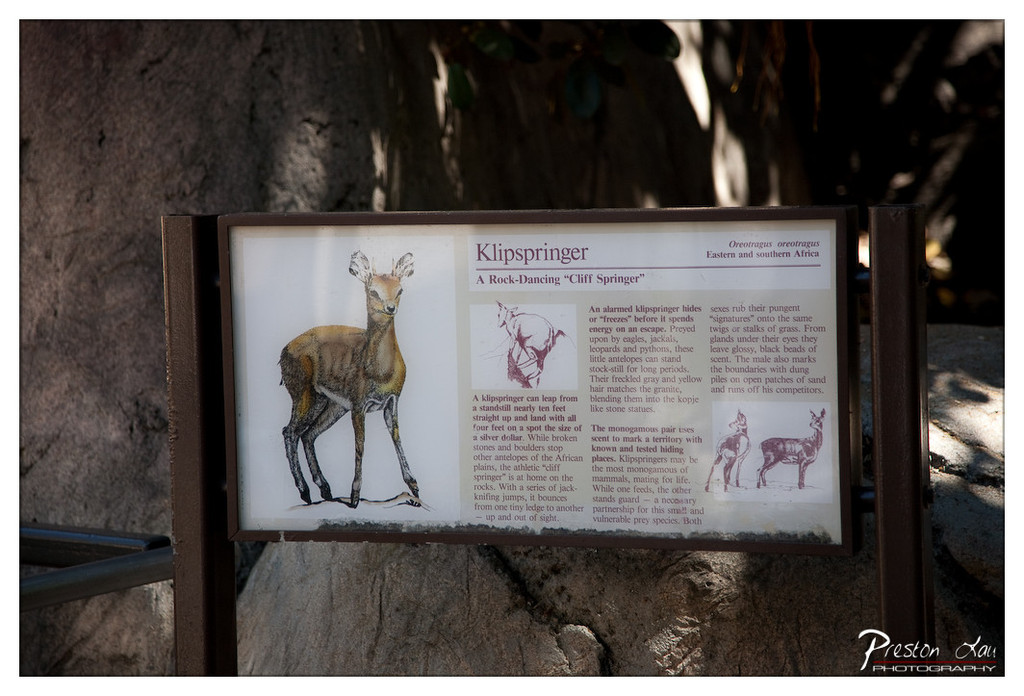

1. Overall Rating (0–10) — 6.0
This photograph captures an informative zoo exhibit sign with a quiet, observational tone, presenting the klipspringer in a naturalistic setting. The composition balances educational content with environmental context, though the subject matter is inherently static, limiting dynamic visual engagement. While the image successfully documents the scene, it lacks the emotional resonance or artistic flair to elevate it beyond a straightforward informational record.
2. Composition (0–10) — 6.5
The sign is centered and clearly framed, with the surrounding rock and foliage creating a naturalistic backdrop. The slight angle adds depth, but the off-center placement of the sign and the distracting foreground elements slightly disrupt visual harmony.
3. Lighting (0–10) — 6.0
Natural, dappled sunlight creates soft highlights and shadows, enhancing texture in the rock wall. However, the uneven exposure results in some overexposed areas on the sign, reducing readability of the text in brighter spots.
4. Color & Tone (0–10) — 6.0
The palette is earthy and muted, with browns, grays, and greens that reflect the natural habitat. While the colors are cohesive, the overall tone is somewhat flat, lacking vibrancy and contrast that could make the illustration pop.
5. Creativity (0–10) — 5.5
The image functions as a straightforward documentation rather than a creative interpretation. The choice to include the environment adds context, but the approach is conventional, with little narrative or stylistic innovation.
6. Technical Quality (0–10) — 7.5
The focus is sharp on the sign, and the details of the text and illustration are clear. The image is well-exposed overall, though some areas show minor overexposure due to direct sunlight.
7. Emotional Impact (0–10) — 5.0
The image conveys a sense of calm observation, but the subject matter and neutral tone limit emotional engagement. It invites curiosity about the klipspringer, but the photograph itself remains detached and functional.
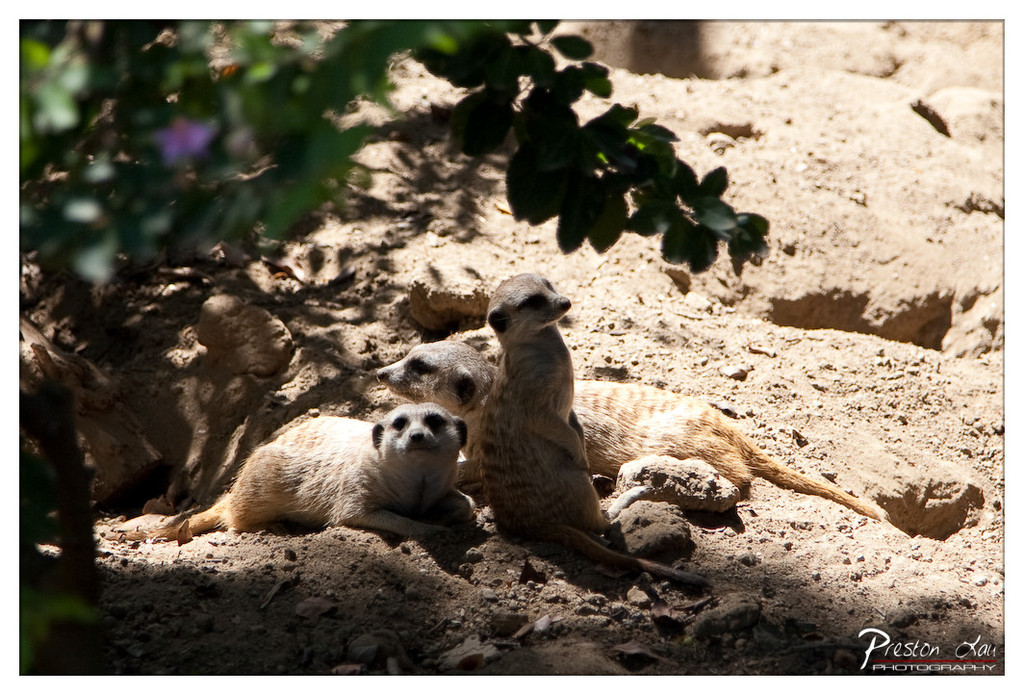

1. Overall Rating (0–10) — 7.0
This photograph captures a tender moment among meerkats in their natural habitat, where sunlight and shadow play across the sandy terrain to create a sense of quiet vigilance. The central standing meerkat draws the eye with its alert posture, while the others rest in repose, offering a glimpse into the social dynamics of the group. The image succeeds in balancing narrative and atmosphere, though a slightly more refined composition could enhance its visual cohesion.
2. Composition (0–10) — 6.5
The meerkats are well-placed within the frame, with the standing one creating a natural focal point. However, the overhanging foliage on the left and the uneven ground slightly disrupt the balance, and the framing could be tighter to emphasize the group’s interaction.
3. Lighting (0–10) — 7.5
The dappled sunlight creates strong contrast between light and shadow, highlighting texture in the fur and sand. The directional light adds depth and drama, enhancing the natural mood of the scene.
4. Color & Tone (0–10) — 6.5
The warm, earthy tones of the sand and fur are well-rendered, though the overall palette leans slightly flat. A touch more vibrancy in the greens and yellows could add visual energy without detracting from the naturalism.
5. Creativity (0–10) — 7.0
The image captures a candid, emotionally resonant moment in wildlife behavior, with the contrast between vigilance and rest suggesting a quiet story. The photographer’s ability to capture the group’s dynamic is its strongest creative element.
6. Technical Quality (0–10) — 8.0
Sharp focus on the meerkats, clean detail in the fur and environment, and well-handled exposure contribute to a technically strong image. The watermark is unobtrusive and professionally placed.
7. Emotional Impact (0–10) — 7.5
The alert posture of the central meerkat evokes a sense of watchfulness and responsibility, while the relaxed others convey trust and community. The viewer is drawn into the animals’ world, feeling a quiet connection to their social bond.
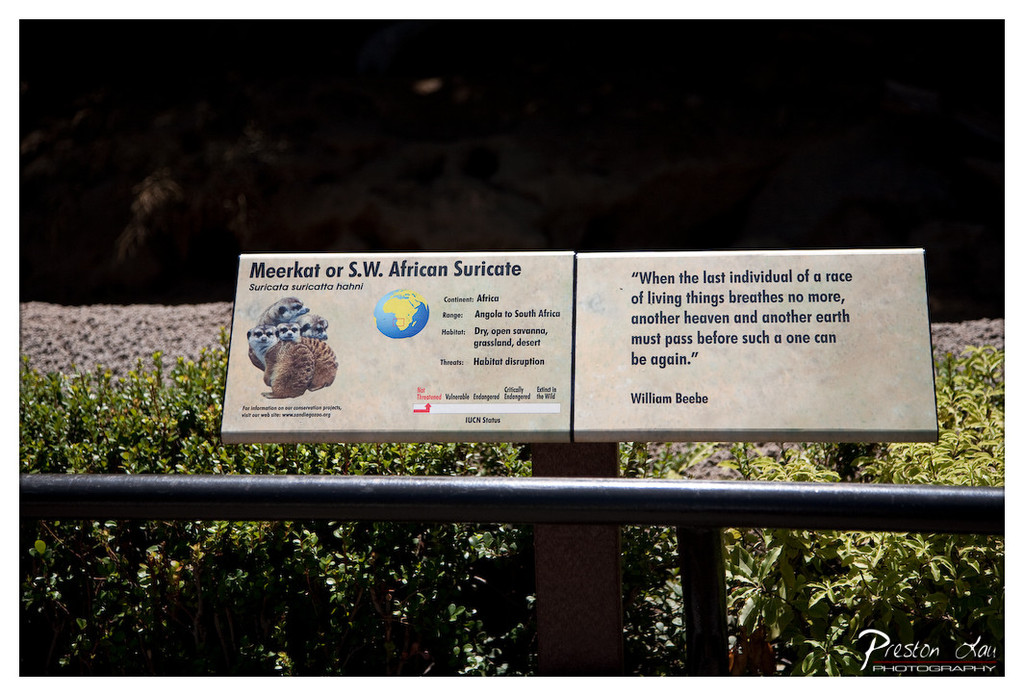

1. Overall Rating (0–10) — 6.0
This photograph captures a quiet, educational moment at a zoo or wildlife exhibit, where the juxtaposition of scientific facts and poetic reflection creates a contemplative mood. The signage, though informative, is slightly overwhelmed by its surroundings—busy foliage and harsh shadows detract from the clarity of the message. While the image successfully conveys a sense of conservation awareness, it lacks the visual cohesion and emotional resonance to feel truly impactful.
2. Composition (0–10) — 5.5
The sign is centered but partially obscured by the railing and surrounding greenery, which creates visual clutter. The framing feels slightly off-kilter, with uneven negative space and an overbearing foreground element.
3. Lighting (0–10) — 6.0
Strong directional sunlight creates deep shadows behind the sign, reducing legibility in certain areas. The contrast between bright highlights and dark background adds drama but compromises readability.
4. Color & Tone (0–10) — 5.5
The palette is muted, dominated by greens and grays, with a washed-out beige background on the sign. The lack of vibrancy dampens the visual appeal, though the color choices reflect the naturalistic theme.
5. Creativity (0–10) — 6.5
The inclusion of William Beebe’s quote alongside scientific data adds a layer of philosophical depth, transforming a simple informational display into a reflective statement on extinction and renewal.
6. Technical Quality (0–10) — 7.0
The image is sharp with clear focus on the sign, though slight overexposure on the left side and uneven lighting affect overall quality. The watermark is subtle and unobtrusive.
7. Emotional Impact (0–10) — 6.0
The quote evokes a sense of urgency and reverence for nature, but the visual execution keeps the viewer at a distance—more observational than emotionally engaging.
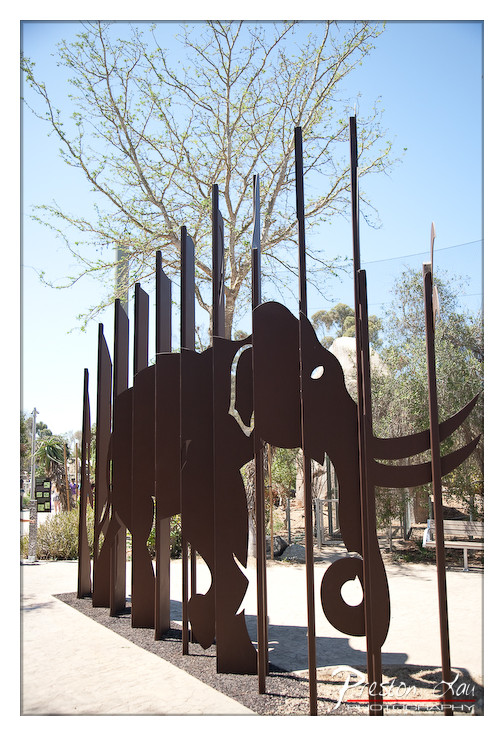

1. Overall Rating (0–10) — 7.0
This photograph captures a bold, sculptural interpretation of a mammoth, its silhouette standing strong against a bright, clear sky. The interplay of the dark metal form and the natural backdrop creates a striking visual contrast, evoking a sense of timelessness and artistic imagination. While the composition is strong, the slightly awkward framing and minor distractions in the background prevent it from achieving full aesthetic cohesion.
2. Composition (0–10) — 6.5
The mammoth sculpture is the clear focal point, but the uneven spacing of the vertical elements and the inclusion of background foliage slightly disrupt visual harmony. A tighter crop would better emphasize the sculpture’s form and balance.
3. Lighting (0–10) — 7.0
Bright, natural daylight enhances the silhouette effect, casting sharp shadows and highlighting the sculpture’s edges. The high contrast between the dark metal and the sunlit sky adds drama and depth.
4. Color & Tone (0–10) — 6.5
The dominant earthy brown of the sculpture contrasts with the pale blue sky and muted greens of the trees, creating a natural yet subdued palette. The tonal range is effective, though the lack of vibrant color reduces the image’s visual energy.
5. Creativity (0–10) — 7.5
The concept of merging a prehistoric creature with a modern, abstract design is imaginative and engaging. The use of vertical slats to form the mammoth adds a unique, layered dimension to the sculpture.
6. Technical Quality (0–10) — 7.5
Sharp focus and good exposure capture fine details in the metal and background. The image is clear and well-executed, with minimal noise or technical flaws.
7. Emotional Impact (0–10) — 6.5
The sculpture evokes curiosity and wonder, bridging the past and present in a quiet, contemplative way. The viewer is invited to reflect on time, nature, and human creativity, though the emotional resonance is somewhat tempered by the image’s straightforward presentation.
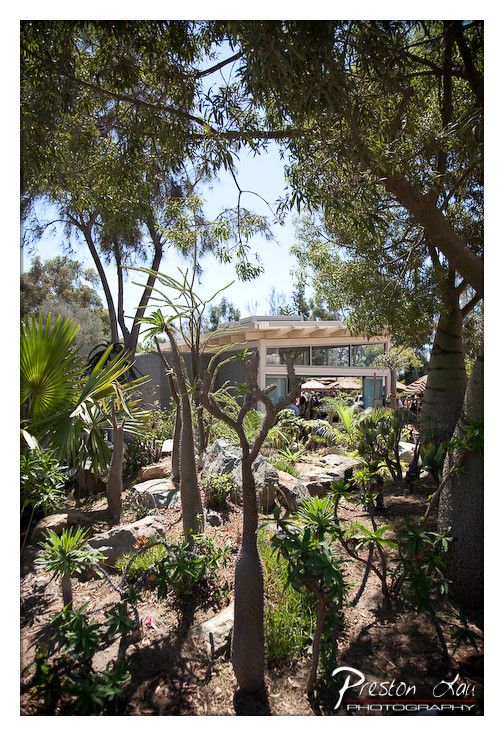

1. Overall Rating (0–10) — 7.0
This photograph captures a serene, sun-dappled garden with a modern structure nestled among lush, sculptural plants, evoking a sense of tranquil harmony between nature and design. The framing through the trees creates a natural vignette, drawing the eye toward the architectural focal point, though the composition feels slightly crowded and lacks a clear visual hierarchy. The lighting and color palette enhance the tropical atmosphere, but the image’s potential is tempered by a lack of decisive focus and subtle post-processing polish.
2. Composition (0–10) — 6.5
The view through the trees creates a natural frame, but the foreground foliage and scattered elements compete for attention. The central building is slightly off-center, and the diagonal lines of the branches and plants create a dynamic but somewhat cluttered arrangement.
3. Lighting (0–10) — 7.0
Bright, natural daylight illuminates the scene, with dappled shadows filtering through the canopy, adding depth and texture. The contrast between sunlit areas and shaded zones enhances dimensionality, though some highlights are slightly overexposed.
4. Color & Tone (0–10) — 6.5
The palette is rich with earthy greens and browns, accented by the pale tones of the building. While the colors are natural and harmonious, the overall tone leans slightly cool and flat, with muted saturation that softens the vibrancy of the foliage.
5. Creativity (0–10) — 7.0
The photographer uses the framing of the trees to create a sense of discovery, inviting the viewer into a secluded, curated landscape. The juxtaposition of organic forms and modern architecture adds conceptual interest and a subtle narrative of coexistence.
6. Technical Quality (0–10) — 7.5
The image is sharp and well-focused, particularly in the mid-ground, with clean detail in the plants and building. The exposure is largely balanced, though some loss of detail in the highlights suggests a narrow dynamic range.
7. Emotional Impact (0–10) — 6.5
The photograph conveys calm and contemplation, inviting a moment of pause in a lush, secluded space. While the scene is peaceful, the emotional resonance is somewhat restrained by the visual busyness of the foreground and lack of a strong focal anchor.
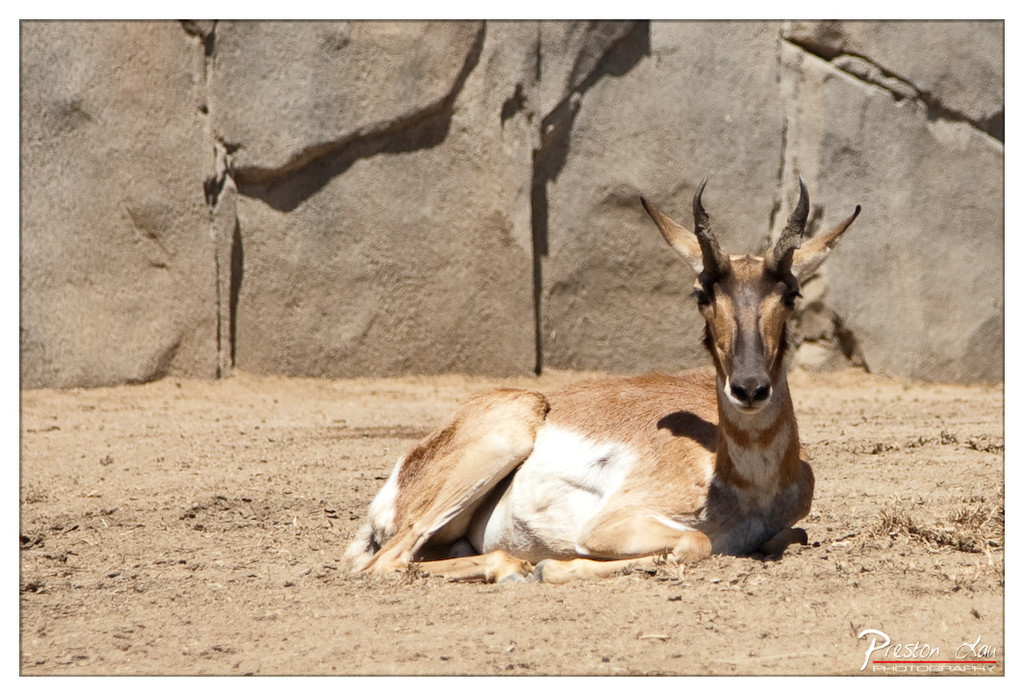

1. Overall Rating (0–10) — 7.0
This photograph captures a serene moment of a pronghorn resting in a sun-drenched enclosure, its alert gaze drawing the viewer into a quiet narrative of watchful calm. The naturalistic setting and direct eye contact create a sense of connection with the animal, while the warm light and earthy tones lend a painterly quality to the scene. A slightly tighter crop and more dynamic lighting could elevate its emotional depth, but as it stands, the image balances stillness and presence with quiet elegance.
2. Composition (0–10) — 7.0
The subject is well-placed in the lower third, creating a balanced and grounded composition. The diagonal lines of the rock wall and the animal’s body lead the eye naturally toward the face, enhancing focus and engagement.
3. Lighting (0–10) — 7.5
Strong, directional sunlight creates rich contrast and defines the animal’s form with clarity. The warm golden tones enhance the texture of the fur and the dusty ground, while soft shadows add depth without obscuring detail.
4. Color & Tone (0–10) — 7.0
The palette is harmonious, dominated by earthy browns, tans, and muted grays that reflect the natural environment. The subtle contrast between the warm fur and cool shadows adds visual interest, though the overall tone leans slightly toward flatness in the background.
5. Creativity (0–10) — 6.5
The image succeeds in capturing a moment of stillness with dignity, but the concept is straightforward—there’s little surprise or narrative innovation. The strength lies in its restraint and realism rather than bold artistic vision.
6. Technical Quality (0–10) — 8.0
The focus is sharp on the pronghorn’s face, with fine detail visible in the fur and horns. The exposure is well-balanced, and the image is free of noticeable noise or distortion.
7. Emotional Impact (0–10) — 7.5
The direct gaze of the pronghorn evokes a sense of quiet awareness and vulnerability, inviting empathy. The stillness of the scene resonates emotionally, creating a contemplative mood that lingers beyond the frame.
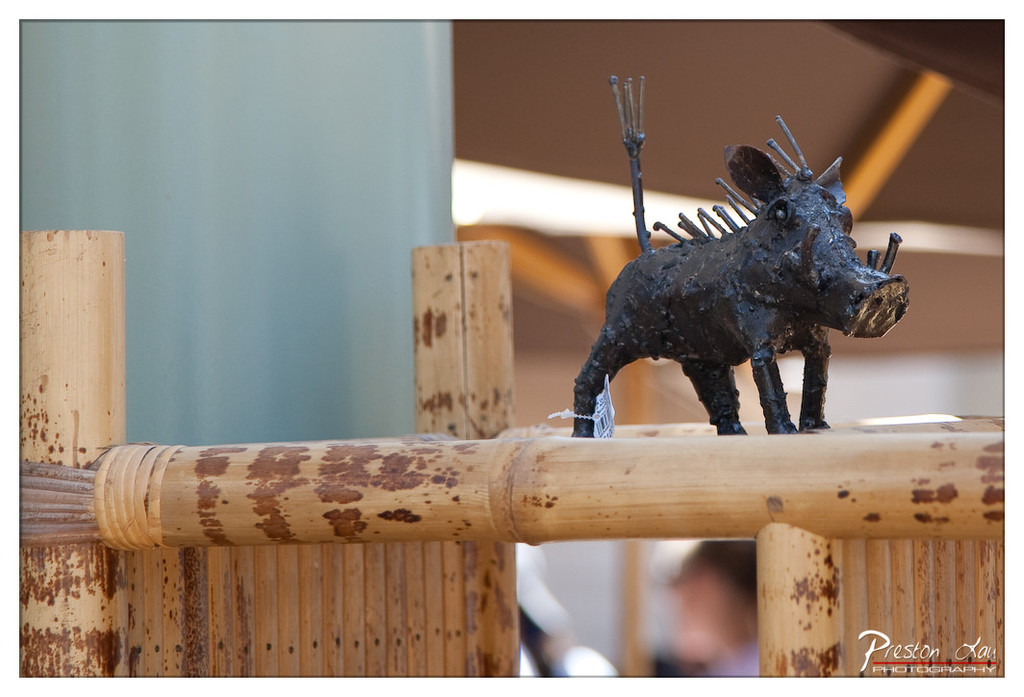

1. Overall Rating (0–10) — 7.0
This photograph captures a rustic, handcrafted metal sculpture of a warthog perched atop a weathered bamboo railing, evoking a sense of artisanal charm and playful whimsy. The contrast between the dark, textured metal and the natural grain of the bamboo creates a compelling visual dialogue between man-made and organic forms. While the image is rich in texture and narrative potential, the shallow depth of field and slightly cluttered background distract from the sculpture’s full expressive power.
2. Composition (0–10) — 6.5
The warthog sculpture is well-placed along the diagonal line of the bamboo railing, guiding the eye through the frame. However, the uneven spacing of the vertical posts and the soft blur of the background slightly disrupt the visual harmony.
3. Lighting (0–10) — 7.0
Soft, diffused daylight highlights the sculpture’s texture and form without harsh shadows, enhancing the tactile quality of the metal. The light from the upper right adds dimension and depth to the subject.
4. Color & Tone (0–10) — 7.0
The muted earth tones of the bamboo and the dark, matte finish of the metal create a cohesive, natural palette. The subtle blue-green background adds a cool counterpoint, enhancing the visual contrast without overpowering the scene.
5. Creativity (0–10) — 7.5
The juxtaposition of a handmade, animal-inspired sculpture against a simple bamboo structure suggests a story of craftsmanship and cultural expression. The choice to focus on this quiet, unassuming moment gives the image a quiet originality.
6. Technical Quality (0–10) — 8.0
Sharp focus on the sculpture with a smooth, gradual fall-off into the background demonstrates effective use of depth of field. The image is clean, well-exposed, and free of technical flaws.
7. Emotional Impact (0–10) — 6.5
The image conveys a sense of quiet pride in handcrafted art, inviting viewers to appreciate the details of the sculpture and its setting. While it doesn’t evoke strong emotion, it lingers with a sense of warmth and authenticity.
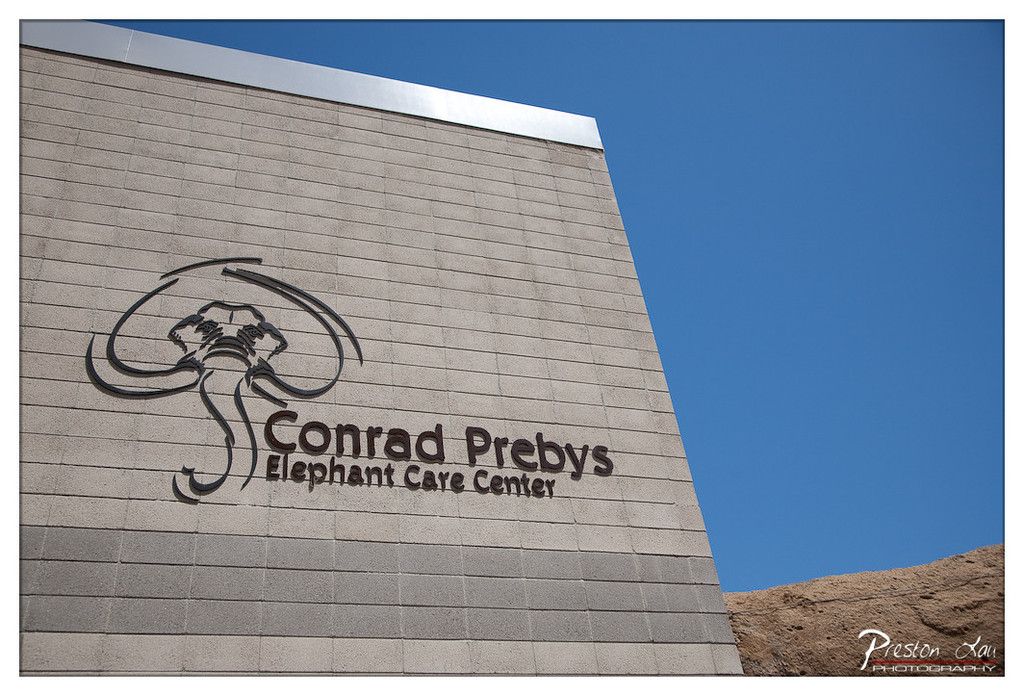

1. Overall Rating (0–10) — 7.0
This photograph captures the Conrad Preby’s Elephant Care Center with a clean, architectural clarity that emphasizes its modern identity. The bold, minimalist logo stands out against the textured brick wall, while the expansive blue sky adds a sense of openness and serenity. While the image is strong in composition and lighting, it feels more like a straightforward documentation than a deeply evocative portrait, lacking a layer of narrative or emotional depth that would elevate it beyond a simple signpost.
2. Composition (0–10) — 8.0
The low-angle perspective creates a sense of grandeur, while the diagonal line of the building leads the eye naturally toward the logo. The negative space of the sky balances the weight of the structure, giving the image a dynamic yet stable frame.
3. Lighting (0–10) — 9.0
The bright, even daylight enhances the contrast between the dark lettering and the light-colored wall, while the crisp blue sky provides a rich, saturated backdrop. The absence of harsh shadows suggests optimal lighting conditions, contributing to the image’s clarity.
4. Color & Tone (0–10) — 8.0
The cool tones of the blue sky and gray brick create a harmonious palette, with the dark brown logo providing a focal point. The overall tone is clean and balanced, with sufficient contrast to make the text legible and visually striking.
5. Creativity (0–10) — 6.0
The concept is straightforward—documenting a facility—but the low-angle framing and clean composition lend it a subtle sense of purpose. While not highly original, the image effectively communicates identity and place.
6. Technical Quality (0–10) — 9.0
Sharp focus and precise detail across the frame, from the texture of the bricks to the clarity of the logo, demonstrate strong technical execution. The exposure is well-managed, with no overexposed or underexposed areas.
7. Emotional Impact (0–10) — 5.5
The image conveys professionalism and stability, but it remains emotionally neutral. It informs rather than inspires, offering a sense of place without evoking deeper sentiment or connection.
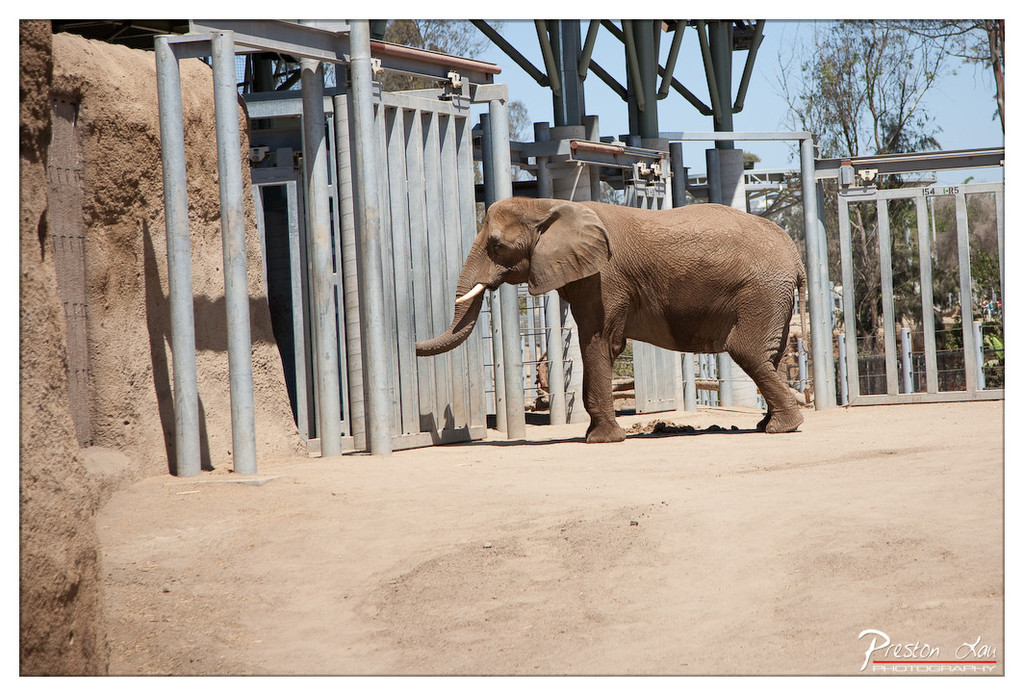

1. Overall Rating (0–10) — 6.0
This photograph captures a powerful moment of an elephant moving through a man-made enclosure, where the juxtaposition of natural form and industrial structure evokes a subtle tension. The elephant’s calm gait and presence lend a quiet dignity to the scene, though the surrounding infrastructure detracts from the sense of wildness. While the image effectively documents a real moment in a zoo habitat, it lacks the visual poetry to transcend mere documentation.
2. Composition (0–10) — 6.5
The elephant is placed off-center, creating a sense of movement toward the left, but the framing feels slightly unbalanced due to the heavy verticals of the metal gates. The dirt ground and earthy wall provide visual grounding, but the composition is hindered by the cluttered background.
3. Lighting (0–10) — 7.0
Bright, natural daylight illuminates the scene evenly, highlighting the texture of the elephant’s skin and the dusty ground. The strong sunlight casts clear shadows, adding depth, though the harshness slightly flattens the emotional tone.
4. Color & Tone (0–10) — 6.0
The palette is dominated by earthy browns and muted grays, which harmonize well with the subject and environment. However, the lack of vibrant color limits the image’s visual energy, giving it a muted, almost documentary feel.
5. Creativity (0–10) — 5.5
The concept is straightforward—capturing an elephant in a zoo setting—but the image doesn’t push beyond realism into symbolic or emotional interpretation. The contrast between the animal and its environment is present but not deeply explored.
6. Technical Quality (0–10) — 7.5
The image is sharp and well-focused, with clear detail in both the elephant and the surrounding structures. The exposure is well-balanced, and the depth of field appropriately isolates the subject.
7. Emotional Impact (0–10) — 5.0
While the elephant’s presence evokes a sense of strength and quiet endurance, the clinical setting and lack of narrative depth limit emotional resonance. The viewer is left observing rather than feeling.
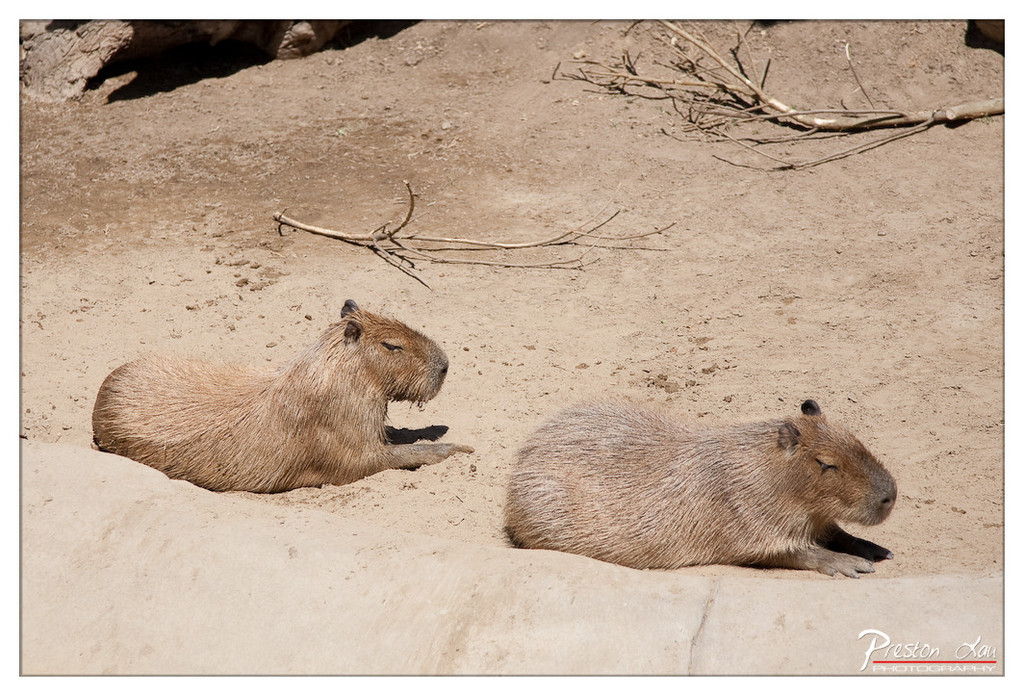

1. Overall Rating (0–10) — 6.8
This photograph captures a serene moment between two capybaras basking in the sun, their calm demeanor evoking a sense of quiet companionship. The naturalistic setting and warm lighting lend a peaceful, almost meditative quality to the scene. While the image is visually engaging and well-framed, it lacks the dramatic tension or compositional flair that would elevate it beyond a pleasant snapshot into the realm of fine art.
2. Composition (0–10) — 6.5
The two capybaras are placed off-center, creating a balanced yet slightly asymmetrical arrangement that draws the eye across the frame. The diagonal line of the sandy slope adds subtle movement, though the background clutter of branches slightly distracts from the subjects.
3. Lighting (0–10) — 7.5
Bright, natural sunlight enhances the texture of the capybaras’ wet fur and casts soft shadows that define their forms. The warm tone of the light contributes to the tranquil atmosphere, though some areas of the background are slightly overexposed.
4. Color & Tone (0–10) — 7.0
The palette is dominated by warm, earthy tones—beiges and tans—that harmonize beautifully with the capybaras’ natural coloring. The color balance is consistent and natural, with a slight emphasis on warmth that enhances the sunlit mood.
5. Creativity (0–10) — 6.0
The image is grounded in realism, capturing a genuine moment in a naturalistic environment. While it reflects a thoughtful approach to timing and framing, the concept is conventional—there is little innovation in perspective or narrative beyond the inherent charm of the subjects.
6. Technical Quality (0–10) — 7.5
The photograph is sharp and well-focused, with clear detail in the capybaras’ fur and the surrounding terrain. The exposure is well-managed, though minor overexposure in the background suggests slight limitations in dynamic range.
7. Emotional Impact (0–10) — 7.0
The peaceful demeanor of the capybaras and the quiet stillness of the scene evoke a sense of calm and contentment. The viewer is invited into a moment of quiet coexistence, making the image emotionally resonant despite its simplicity.
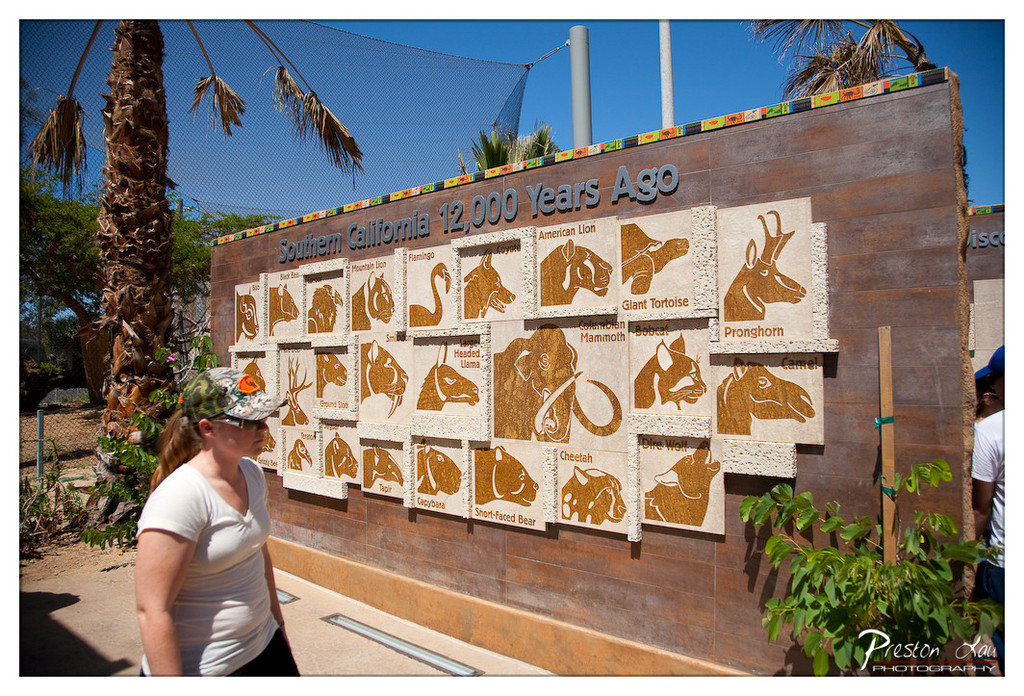

1. Overall Rating (0–10) — 6.0
This photograph captures a moment of quiet observation at a natural history exhibit, where a visitor pauses before a detailed wall display about prehistoric fauna. The composition effectively frames the educational content, while the bright sunlight and clear sky lend a sense of openness and clarity. However, the image feels more like a casual snapshot than a fully realized artistic statement, with its focus on documentation over emotional resonance or visual storytelling.
2. Composition (0–10) — 6.5
The subject is placed off-center, creating a sense of movement as the woman walks past the wall. The diagonal line of the wall draws the eye across the frame, though the cluttered arrangement of animal silhouettes and the partial framing of the woman slightly disrupt visual flow.
3. Lighting (0–10) — 7.5
Strong, direct sunlight enhances clarity and contrast, emphasizing the textures of the stone carvings and the vividness of the blue sky. The harsh light creates deep shadows, adding dimension but also casting some areas into overexposure.
4. Color & Tone (0–10) — 6.5
The warm, earthy tones of the wall and the golden animal silhouettes harmonize with the green of the palm fronds and the deep blue sky. The overall palette is natural and cohesive, though the lack of color saturation slightly dulls the visual impact.
5. Creativity (0–10) — 5.5
The image is conceptually straightforward, serving as a document of a cultural and educational site. While the subject matter is interesting, the execution lacks a unique perspective or artistic reinterpretation, feeling more observational than expressive.
6. Technical Quality (0–10) — 7.0
The image is sharp and well-focused, with fine detail visible in the wall carvings and the woman’s features. The exposure is generally balanced, though some highlights in the sky are slightly blown out.
7. Emotional Impact (0–10) — 5.0
The photograph conveys a sense of curiosity and quiet engagement, but the emotional connection is limited. The viewer is invited to observe rather than feel, as the scene remains detached and factual in tone.
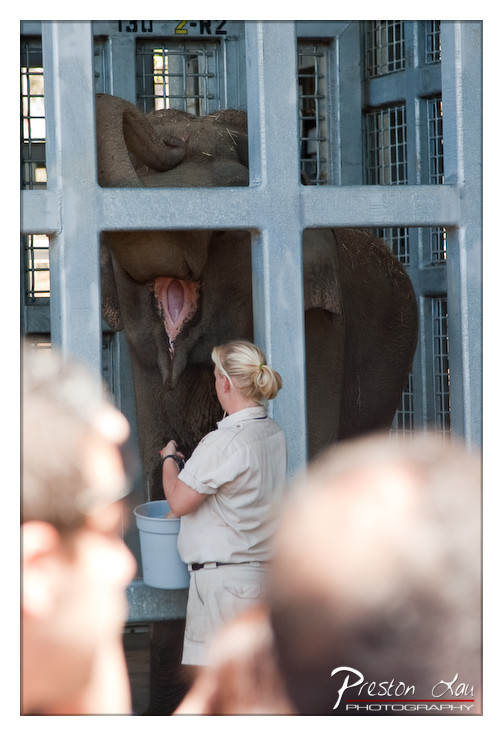

1. Overall Rating (0–10) — 6.8
This photograph captures a poignant moment of human-animal interaction within a restrictive environment, where the juxtaposition of care and confinement evokes a complex emotional response. The central figure—a zookeeper tending to an elephant—suggests a narrative of routine and compassion, yet the steel bars and crowded foreground create a sense of intrusion and distance. While the image succeeds in conveying the tension between intimacy and captivity, its emotional weight is slightly diminished by a lack of visual clarity and compositional focus.
2. Composition (0–10) — 5.5
The framing is awkward, with blurred heads in the foreground that obstruct the view and distract from the main subject. The elephant and keeper are centered, but the dominant vertical bars create a rigid, prison-like structure that overwhelms the scene, reducing the visual harmony.
3. Lighting (0–10) — 6.0
Natural daylight illuminates the scene evenly, but the harshness of the light flattens the textures of the elephant’s skin and the keeper’s uniform. The light is functional but lacks the warmth or directionality needed to enhance mood or depth.
4. Color & Tone (0–10) — 6.5
The palette is muted, dominated by grays and earth tones, which reinforce the institutional atmosphere. While the colors are consistent and realistic, they lack vibrancy, contributing to a somber and detached tone.
5. Creativity (0–10) — 7.0
The image presents a compelling narrative about care and captivity, using a candid moment to invite reflection. The use of foreground blur adds a layer of voyeurism, suggesting the viewer’s role as an observer, which is a thoughtful compositional choice.
6. Technical Quality (0–10) — 7.5
The focus is sharp on the keeper and the elephant’s open mouth, and the depth of field is used effectively to blur the foreground. The image is clear and well-exposed, though the noise in the darker areas slightly detracts from the overall quality.
7. Emotional Impact (0–10) — 7.0
The photograph evokes a quiet tension—affection and duty contrasted with confinement. The viewer is drawn into a moment of connection, yet the bars and crowded setting create a sense of unease, prompting reflection on the ethics of animal care in captivity.
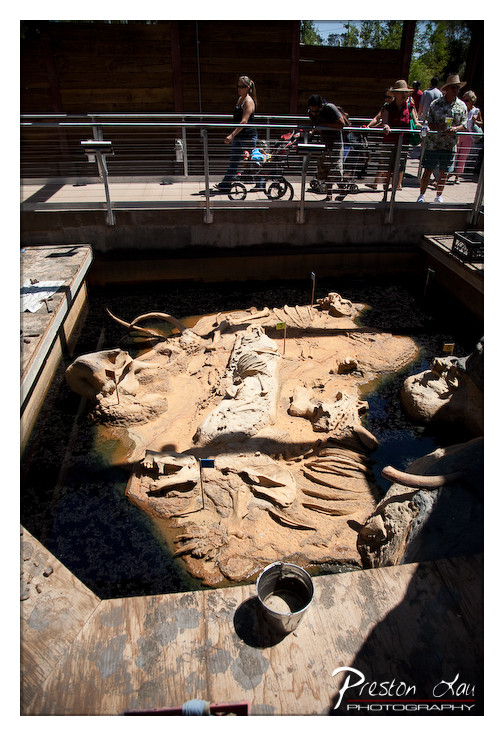

1. Overall Rating (0–10) — 7.0
This photograph captures the dramatic tension between ancient history and modern observation, with fossilized remains embedded in a sunlit excavation pit. The interplay of light and shadow enhances the texture and scale of the bones, while the presence of visitors above adds narrative depth, grounding the scene in a contemporary moment of discovery. The image is compelling in its storytelling, though the composition’s slight imbalance and overexposed highlights temper its visual impact.
2. Composition (0–10) — 6.5
The low-angle perspective emphasizes the depth of the excavation, but the foreground elements and the diagonal railing disrupt visual flow. A tighter framing would better center the fossils and improve compositional harmony.
3. Lighting (0–10) — 7.5
Strong overhead sunlight creates bold contrasts and deep shadows, accentuating the rugged textures of the fossil bed. The bright highlights on the water and railings add visual interest, though some areas are slightly overexposed.
4. Color & Tone (0–10) — 6.5
The warm, earthy tones of the sand and fossils dominate, creating a natural, organic palette. However, the cool blue of the water and the muted tones of the surrounding structure introduce a slight visual dissonance.
5. Creativity (0–10) — 7.0
The juxtaposition of ancient remains and modern visitors offers a compelling narrative, suggesting a dialogue between past and present. The photograph successfully captures a moment of public engagement with paleontology, elevating it beyond a simple documentation.
6. Technical Quality (0–10) — 7.0
Sharp focus and clear detail are evident in the fossilized bones and surrounding textures. The image is well-exposed overall, though some highlight loss in the brightest areas reduces tonal richness.
7. Emotional Impact (0–10) — 7.5
The image evokes a sense of awe and curiosity, inviting the viewer to contemplate the passage of time and the fragility of life. The human presence adds a layer of relatability, making the ancient past feel accessible and immediate.
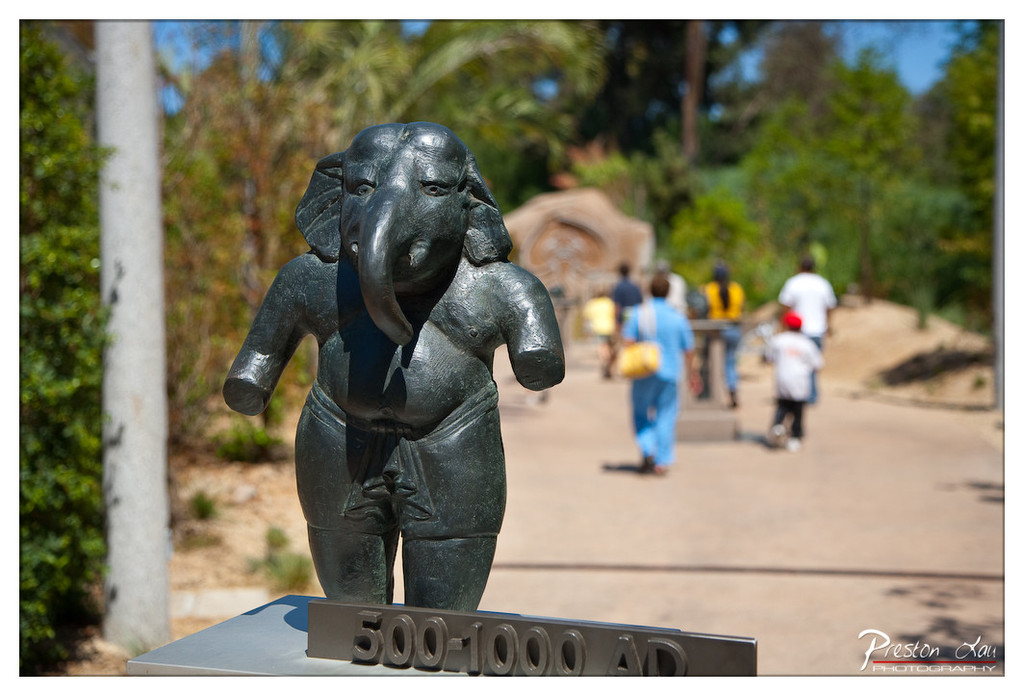

1. Overall Rating (0–10) — 7.0
This photograph captures a whimsical yet historically grounded moment, where a playful elephant statue serves as both a cultural artifact and a visual anchor in a bustling outdoor setting. The shallow depth of field draws the eye to the sculpture while gently blurring the passersby, creating a layered narrative between past and present. While the composition is strong and the subject engaging, the slightly overexposed sky and lack of atmospheric contrast temper its overall impact.
2. Composition (0–10) — 7.5
The statue is well-placed in the foreground, drawing immediate attention, while the diagonal path and walking figures create a sense of movement and depth. The blurred background enhances focus on the subject without overwhelming the frame.
3. Lighting (0–10) — 6.5
Bright, direct sunlight creates strong highlights on the statue and casts distinct shadows, but the sky is slightly overexposed, reducing detail in the upper portion of the image. The light emphasizes texture but lacks subtlety.
4. Color & Tone (0–10) — 6.0
The image features a natural, earthy palette with muted greens, browns, and the dark patina of the statue. While harmonious, the colors lack vibrancy and contrast, giving the scene a slightly flat appearance.
5. Creativity (0–10) — 7.0
The juxtaposition of a historical artifact with modern visitors introduces a playful narrative about time, culture, and public space. The use of selective focus adds a cinematic quality, enhancing the story behind the image.
6. Technical Quality (0–10) — 7.5
Sharp focus on the statue is excellent, with clear detail in the sculpture’s surface and the engraved text. The overall exposure is well-handled aside from the blown-out sky.
7. Emotional Impact (0–10) — 6.5
The image evokes curiosity and a sense of gentle nostalgia, inviting viewers to imagine the story behind the statue and the people passing through. It feels personal and grounded, though the emotional resonance is moderated by the image’s documentary tone.
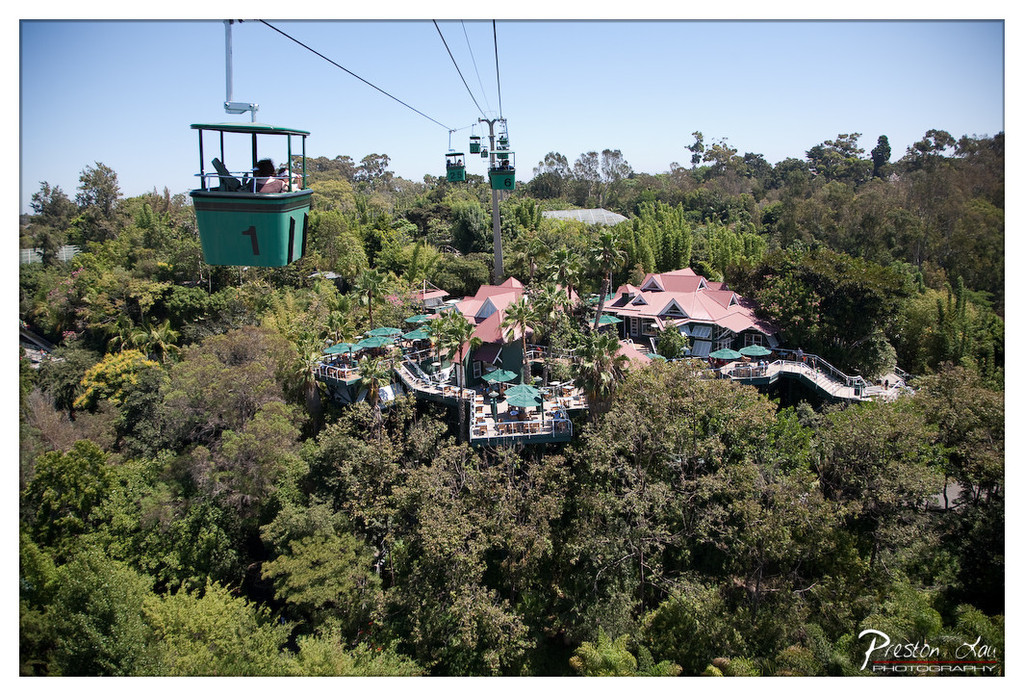

1. Overall Rating (0–10) — 7.0
This photograph captures a vibrant, sun-drenched view of a cable car system weaving through a lush, tropical landscape, evoking a sense of adventure and leisure. The contrast between the man-made structures and the dense greenery creates a compelling narrative of coexistence, while the bright daylight enhances the scene’s inviting atmosphere. The image succeeds in conveying a feeling of movement and exploration, though the composition’s wide framing slightly dilutes the visual focus.
2. Composition (0–10) — 6.5
The cable car in the foreground draws the eye, but the expansive view of the treetops and buildings spreads the focus too thin. A tighter crop would emphasize the central structures and enhance narrative clarity.
3. Lighting (0–10) — 8.0
Bright, natural sunlight bathes the scene in a clear, vivid glow, enhancing detail and depth across the foliage and architecture. The strong overhead light minimizes harsh shadows and contributes to the image’s energetic mood.
4. Color & Tone (0–10) — 7.5
The rich greens of the trees contrast beautifully with the red rooftops and the teal cable cars, creating a balanced and vibrant palette. The overall tone is warm and inviting, with excellent saturation that enhances the tropical feel.
5. Creativity (0–10) — 7.0
The perspective offers a unique vantage point, blending natural and constructed elements in a way that suggests both travel and tranquility. While the concept is familiar, the execution feels fresh and engaging.
6. Technical Quality (0–10) — 8.0
The image is sharp and well-focused, with clean details in both the foreground and background. The exposure is well-balanced, and the lens quality captures fine textures in the foliage and architecture.
7. Emotional Impact (0–10) — 7.0
The photograph evokes a sense of joy and wanderlust, inviting the viewer to imagine gliding through the canopy on a warm, sunny day. The combination of nature and human activity creates a feeling of peaceful adventure.
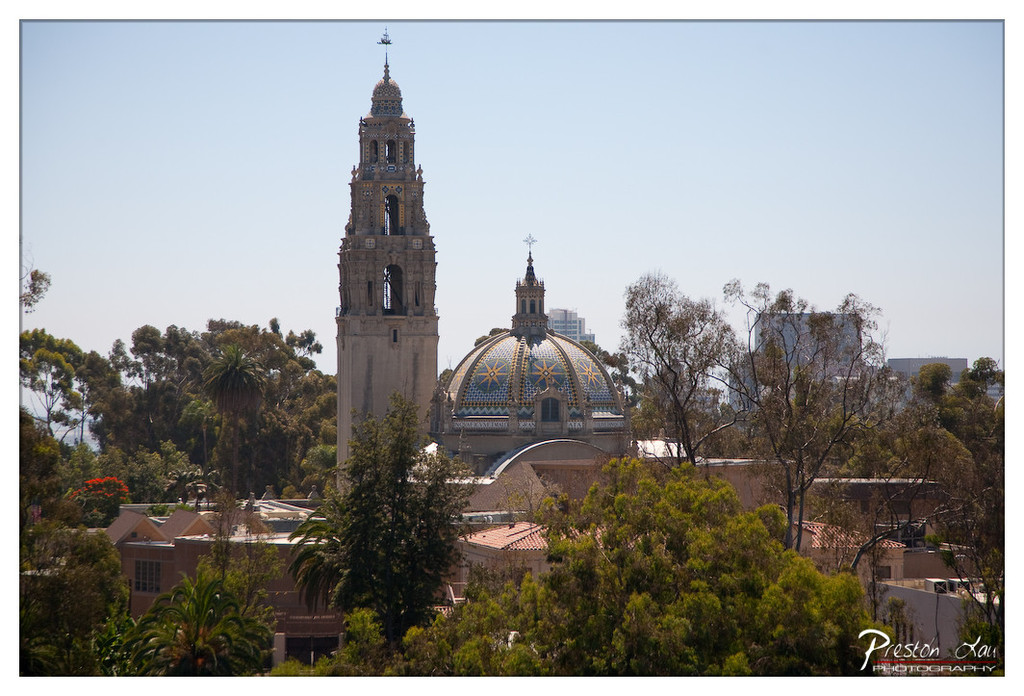

1. Overall Rating (0–10) — 7.5
This photograph captures the majestic presence of a historic architectural landmark, its ornate dome and bell tower rising above a canopy of green trees with quiet dignity. The composition balances natural foliage with urban structure, creating a harmonious blend of nature and culture. While the image is strong in its clarity and subject matter, it slightly lacks dynamic tension, feeling more like a well-composed snapshot than a deeply evocative statement.
2. Composition (0–10) — 7.0
The tower and dome are well-centered, creating a strong focal point, though the foreground foliage slightly obscures the lower portion of the architecture. The layered arrangement of trees, buildings, and sky adds depth, but the framing could be tighter to emphasize the landmark’s grandeur.
3. Lighting (0–10) — 8.0
Bright, natural daylight enhances the textures and colors of the structure, with soft shadows that define form without overpowering detail. The clear sky provides a clean backdrop, allowing the building to stand out with clarity and presence.
4. Color & Tone (0–10) — 7.5
The warm stone tones of the building contrast beautifully with the vibrant blue and gold of the tiled dome, while the green foliage adds natural balance. The overall tone is warm and inviting, with a pleasing color harmony that supports the image’s cultural richness.
5. Creativity (0–10) — 7.0
The photograph successfully captures a recognizable architectural marvel, but its approach is conventional. There’s little stylistic innovation or interpretive flair, making it more documentary than artistically experimental.
6. Technical Quality (0–10) — 8.5
Sharp focus, accurate exposure, and clean detail across the frame demonstrate strong technical execution. The image is free of noise and distortion, with excellent resolution in both the foreground and background.
7. Emotional Impact (0–10) — 7.0
The image evokes a sense of awe and reverence for historical architecture, inviting the viewer to appreciate the craftsmanship and cultural significance of the site. While emotionally resonant, it doesn’t elicit a deeply personal or stirring response, remaining more observational than intimate.
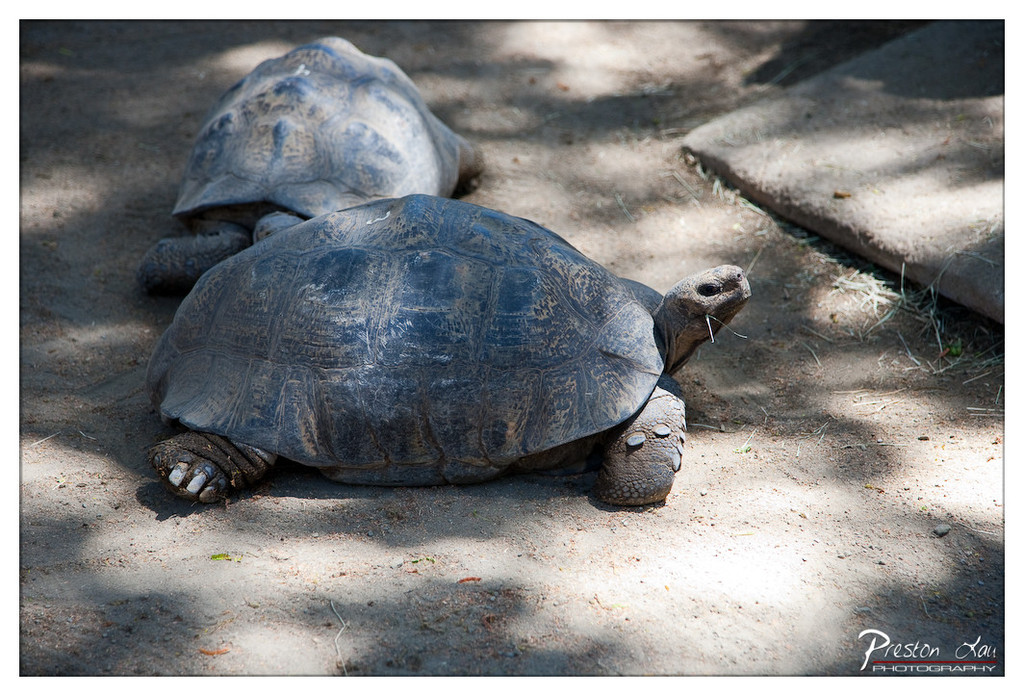

1. Overall Rating (0–10) — 7.0
This photograph captures a serene moment in the life of two giant tortoises, their slow grace underscored by dappled sunlight and shadow. The interplay of light and texture on their weathered shells lends a tactile richness, while the naturalistic setting enhances a sense of quiet contemplation. Though the image is visually grounded and compelling, it holds back from deeper emotional resonance due to a slightly flat lighting approach and lack of dynamic framing.
2. Composition (0–10) — 7.5
The diagonal placement of the tortoises creates a subtle sense of movement, leading the eye from the foreground toward the background. The shallow depth of field isolates the subjects effectively, though the right side feels slightly unbalanced by the large, empty patch of stone and sand.
3. Lighting (0–10) — 6.5
Dappled sunlight creates natural contrast and texture, highlighting the tortoises’ shells and the granular ground. However, the harsh patches of bright light and deep shadows reduce tonal range and slightly obscure detail in key areas.
4. Color & Tone (0–10) — 6.0
The palette is dominated by earthy browns and muted grays, lending a natural, subdued tone. While the colors are accurate and harmonious, the lack of vibrancy and tonal variation limits visual excitement.
5. Creativity (0–10) — 7.0
The photographer captures a quiet, observational moment with a strong sense of presence, emphasizing the tortoises’ age and stillness. The choice to focus on the interplay of light and shadow adds a contemplative layer, suggesting more than just a wildlife snapshot.
6. Technical Quality (0–10) — 8.0
The image is sharp and well-focused on the foreground tortoise, with fine detail visible in the shell texture and skin. The depth of field is well-controlled, and the watermark is unobtrusive.
7. Emotional Impact (0–10) — 6.5
The stillness of the scene evokes a sense of timelessness and patience, inviting reflection on nature’s slow rhythms. While the emotional pull is subtle, the viewer is drawn into a moment of peaceful coexistence with these ancient creatures.
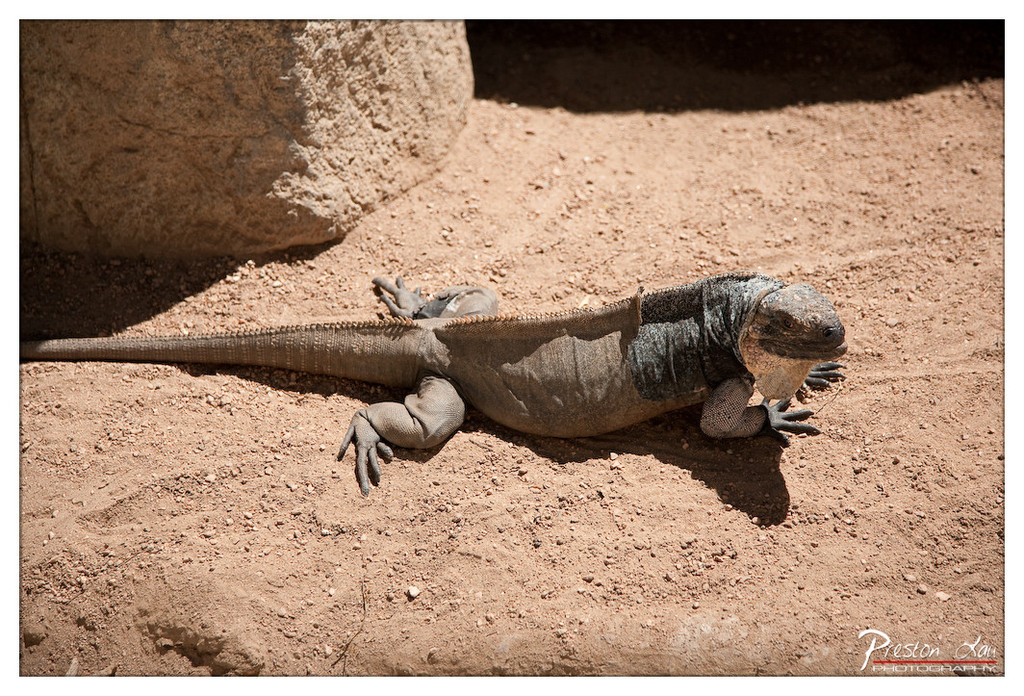

1. Overall Rating (0–10) — 7.0
This photograph captures a striking iguana in a sun-drenched, arid landscape, where the interplay of light and texture gives the scene a raw, naturalistic power. The subject is positioned with quiet dignity, its weathered skin and elongated form conveying a sense of ancient resilience. While the image excels in clarity and environmental authenticity, it holds back slightly from transcendent artistry due to a somewhat conventional framing and lack of deeper narrative tension.
2. Composition (0–10) — 6.5
The iguana is placed diagonally across the frame, creating a sense of movement and balance, though the large rock in the upper left feels slightly overpowering. A tighter crop could emphasize the subject while maintaining the desert atmosphere.
3. Lighting (0–10) — 8.0
Strong, direct sunlight enhances the textures of the sand and the reptile’s scaly skin, casting deep, defined shadows that add depth and dimension to the scene.
4. Color & Tone (0–10) — 7.0
The warm, earthy tones of the sand and the iguana’s grayish-brown body create a cohesive palette, with a natural contrast between light and shadow that feels harmonious and evocative of the desert environment.
5. Creativity (0–10) — 6.5
The image presents a familiar subject with clarity and attention to detail, but its strength lies in documentation rather than bold conceptual or artistic interpretation.
6. Technical Quality (0–10) — 8.5
Sharp focus, clean detail, and precise exposure capture the textures and forms with excellence, showcasing strong technical execution.
7. Emotional Impact (0–10) — 6.5
The image evokes a quiet contemplation of nature’s endurance, but the emotional resonance remains subdued, leaving the viewer as an observer rather than a participant in the moment.
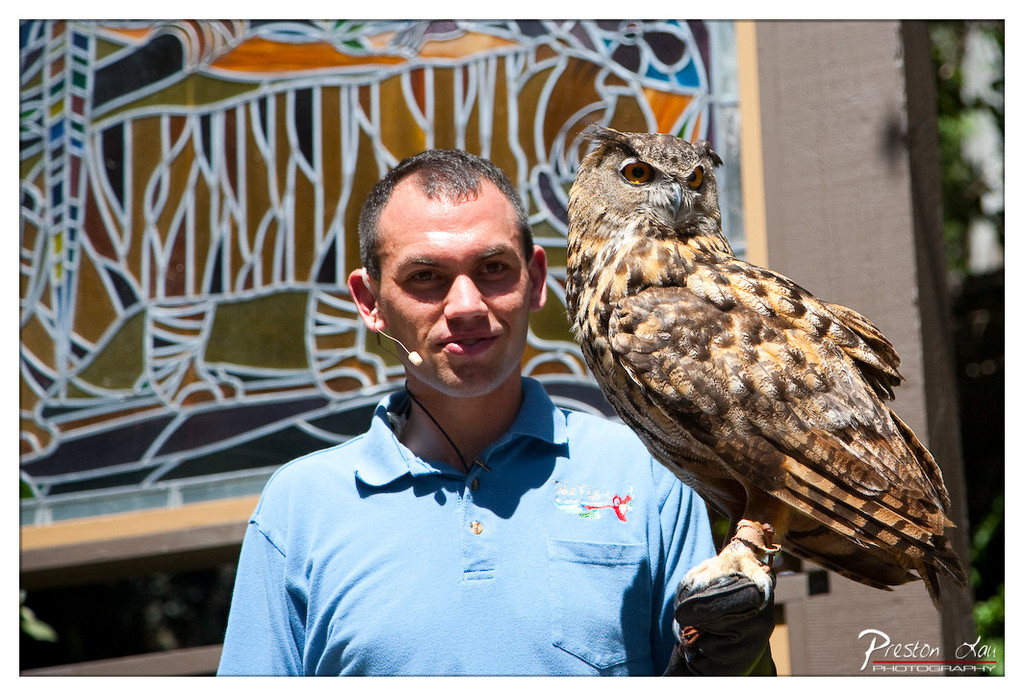

1. Overall Rating (0–10) — 7.5
This portrait captures a striking moment of connection between a handler and a majestic eagle owl, set against a vibrant stained-glass backdrop that adds cultural and visual richness. The subject’s direct gaze and the owl’s intense expression create a compelling narrative of trust and control. While the image is strong in mood and content, the composition and lighting could be more refined to elevate its artistic impact.
2. Composition (0–10) — 6.5
The subject is well-centered, but the owl slightly dominates the frame, creating a slight imbalance. The stained-glass background adds depth but also introduces visual complexity that competes with the main subjects.
3. Lighting (0–10) — 7.0
Natural daylight illuminates the scene evenly, highlighting the texture of the owl’s feathers and the man’s features. The shadows are soft, and the highlights are well-managed, contributing to a clear and readable image.
4. Color & Tone (0–10) — 7.5
The warm, earthy tones of the owl contrast beautifully with the man’s blue shirt and the colorful, abstract background. The color palette is cohesive and enhances the sense of vitality and naturalism.
5. Creativity (0–10) — 7.0
The juxtaposition of the natural bird with the artistic, almost ceremonial backdrop suggests a narrative beyond a simple wildlife portrait. The choice of setting and the handler’s presence elevate the image from a mere documentation to a symbolic encounter.
6. Technical Quality (0–10) — 8.0
Sharp focus on the man and owl, with clean detail in the feathers and facial features. The depth of field is appropriate, keeping the background slightly soft to maintain emphasis on the subjects.
7. Emotional Impact (0–10) — 7.5
The image conveys a sense of calm authority and mutual respect between human and animal. The direct eye contact from both the handler and the owl invites the viewer into a moment of quiet connection, evoking admiration and wonder.
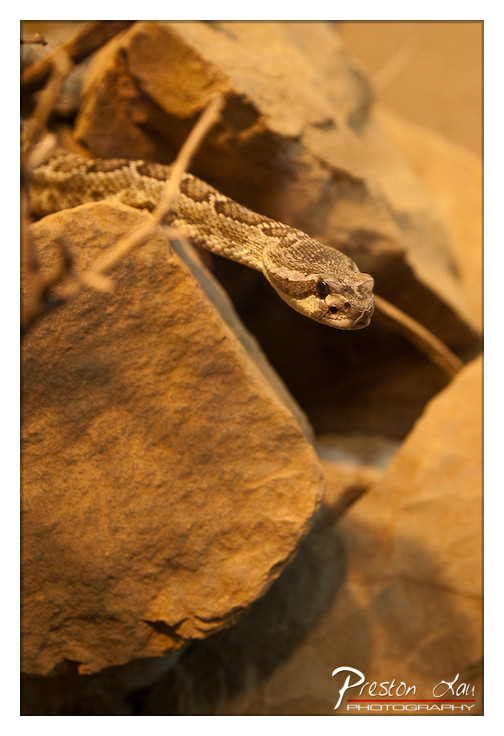

1. Overall Rating (0–10) — 7.0
This photograph captures the coiled tension of a rattlesnake in a naturalistic setting, with a strong sense of quiet alertness. The warm, golden lighting enhances the texture of the snake’s scales and the surrounding rocks, creating a moody, almost cinematic atmosphere. While the image effectively conveys the creature’s stillness and predatory presence, the slightly soft focus and minimal depth of field keep it from achieving a fully immersive impact.
2. Composition (0–10) — 6.5
The snake is well-placed along the diagonal, drawing the eye through the frame, though the tight framing and out-of-focus foreground elements slightly distract from the subject’s head. A more deliberate use of negative space could enhance the sense of isolation and danger.
3. Lighting (0–10) — 7.5
The warm, directional lighting highlights the snake’s head and scales, creating depth and emphasizing texture. The soft shadows add dimension without obscuring detail, giving the scene a natural, intimate glow.
4. Color & Tone (0–10) — 7.0
A cohesive warm palette of golds and browns creates a unified, earthy tone that complements the subject. The subtle contrast between light and shadow enhances the mood, though the color range remains limited, reducing visual dynamism.
5. Creativity (0–10) — 6.5
The image captures a compelling moment in nature with a strong sense of narrative, but its approach is conventional in style. The photographer’s intent to emphasize texture and mood is clear, yet the composition and lighting feel more observational than experimental.
6. Technical Quality (0–10) — 7.5
The focus is sharp on the snake’s head, and the image is free of noise or distortion. The depth of field is controlled, though the background blur is slightly uneven, suggesting a narrow aperture or focus adjustment during capture.
7. Emotional Impact (0–10) — 7.0
The photograph evokes a sense of suspense and quiet intensity, inviting the viewer to contemplate the snake’s vigilance. The proximity and gaze of the animal create a subtle connection, lending a moment of stillness that feels both beautiful and threatening.
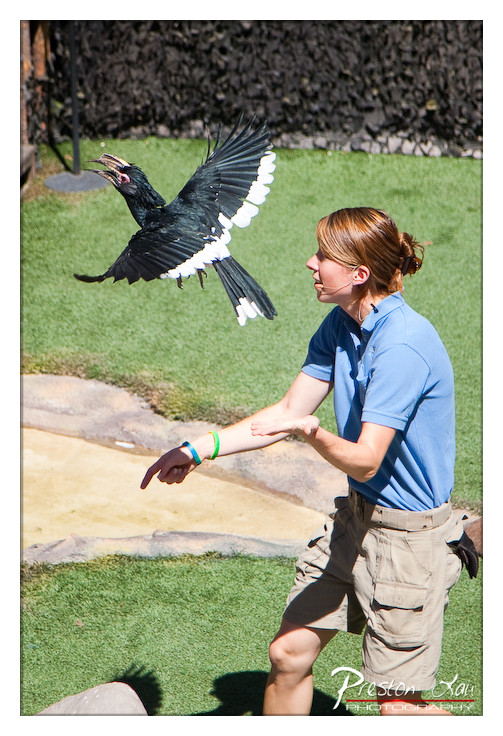

1. Overall Rating (0–10) — 7.5
This image captures a dynamic moment of interaction between a handler and a flying bird, conveying energy and trust in a naturalistic setting. The composition effectively freezes motion, highlighting the bird’s powerful wingspan and the handler’s focused engagement. While the lighting and framing are strong, the background’s slight distraction and flat color palette keep it from achieving full visual harmony.
2. Composition (0–10) — 7.0
The subject is well-placed, with the bird’s trajectory creating a strong diagonal that draws the eye across the frame. The handler’s extended arm guides the viewer’s gaze, though the background elements slightly clutter the space, reducing compositional clarity.
3. Lighting (0–10) — 8.0
Bright, natural sunlight enhances the scene’s clarity and emphasizes the bird’s silhouette and feather detail. The shadows are sharp and well-defined, adding depth and a sense of immediacy to the moment.
4. Color & Tone (0–10) — 6.5
The vibrant green of the grass contrasts with the bird’s black-and-white plumage and the handler’s blue shirt, creating visual interest. However, the overall color balance is slightly cool and flat, with muted tones in the background that dilute the image’s vibrancy.
5. Creativity (0–10) — 7.5
The photograph captures a rare, authentic interaction, showcasing both animal behavior and human connection. The choice to freeze the bird mid-flight adds narrative tension and a sense of movement, elevating the image beyond a simple documentation.
6. Technical Quality (0–10) — 8.0
The focus is sharp on the bird and handler, with excellent clarity in the feathers and clothing. The shutter speed was well-chosen to freeze motion without introducing blur, and the image is free of distracting noise or technical flaws.
7. Emotional Impact (0–10) — 7.0
There’s a palpable sense of trust and coordination between the handler and the bird, evoking admiration for both the animal’s power and the handler’s skill. The moment feels genuine and engaging, inviting the viewer to feel a part of the experience.
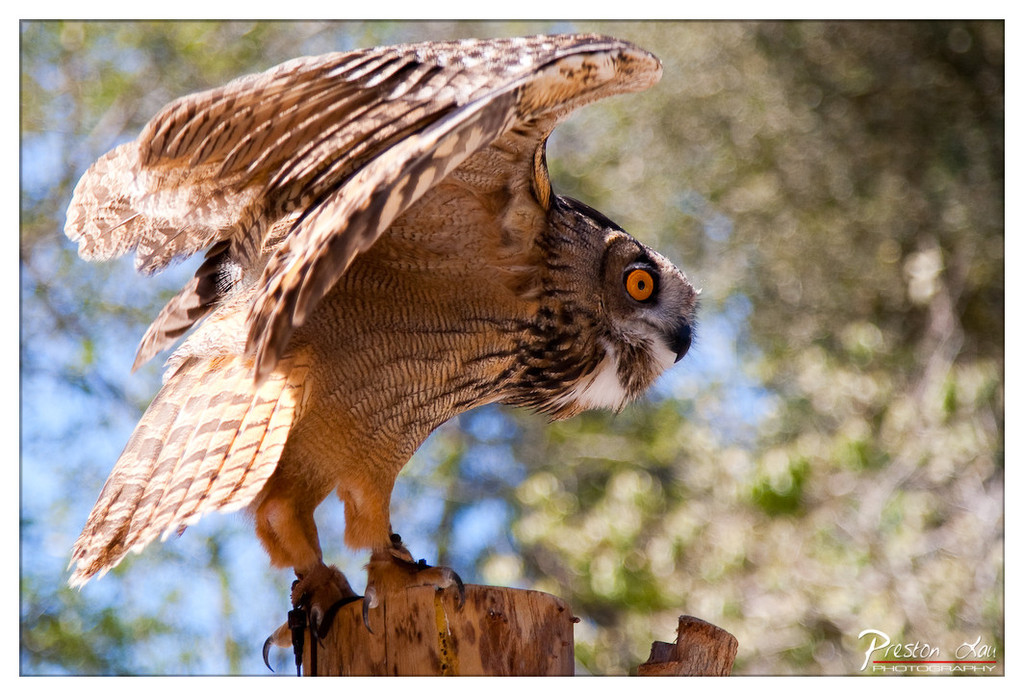

1. Overall Rating (0–10) — 8.0
This photograph captures the majestic presence of an owl in a moment of poised stillness, its wings partially unfurled as if just landing or preparing to take flight. The sharp focus on the bird’s intense gaze and intricate feather patterns contrasts beautifully with the soft, sun-dappled bokeh of the background, creating a dynamic balance between detail and atmosphere. While the image is compelling and technically sound, a slightly more intentional composition could elevate its narrative depth.
2. Composition (0–10) — 7.5
The owl is placed off-center, following the rule of thirds, which enhances visual interest and allows space for the bird’s gaze to lead the eye. The diagonal angle of the wings adds movement, while the blurred natural background keeps the focus firmly on the subject. A tighter crop might further emphasize the owl’s expression and reduce the distraction of the lower wood texture.
3. Lighting (0–10) — 8.5
Natural sunlight illuminates the owl from the side, highlighting the texture and layering of its feathers while casting subtle shadows that give depth to its form. The backlighting creates a soft halo effect on the edges of the wings, enhancing the sense of motion and presence. The exposure is well-balanced, preserving detail in both highlights and shadows.
4. Color & Tone (0–10) — 8.0
The warm golden tones of the owl’s plumage contrast beautifully with the cool blue and green hues of the background, creating a natural and harmonious palette. The vibrant orange of the eye stands out as a focal point, drawing immediate attention. The color rendering is rich yet natural, enhancing the image’s organic feel.
5. Creativity (0–10) — 8.0
The photographer captures a rare moment of avian grace, blending wildlife documentation with artistic intent. The choice to freeze the owl mid-movement, with wings spread and eyes locked in focus, suggests a narrative of alertness and power. The use of shallow depth of field transforms a simple wildlife shot into a portrait of quiet intensity.
6. Technical Quality (0–10) — 9.0
The image is sharp and clear, with precise focus on the owl’s eye and feathers. The fast shutter speed successfully freezes motion without introducing blur, and the depth of field is expertly controlled to isolate the subject. The watermark is subtle and does not detract from the composition.
7. Emotional Impact (0–10) — 8.5
The owl’s piercing gaze and poised stance evoke a sense of wisdom, vigilance, and wild beauty. There is an immediate connection to the animal’s presence—its intensity feels almost personal, as if it is aware of the viewer’s gaze. The image stirs awe and reverence, capturing a fleeting moment of nature’s quiet power.
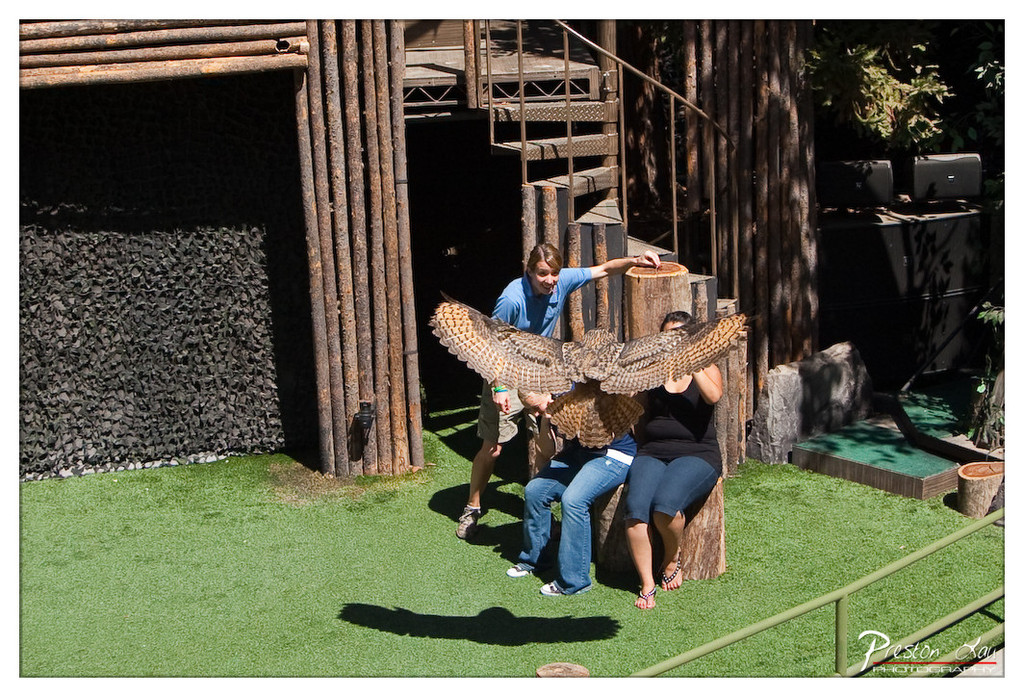

1. Overall Rating (0–10) — 7.0
This photograph captures a dynamic moment during a bird-of-prey demonstration, where the expansive wingspan of an owl dominates the frame with striking presence. The interplay between the handler, the audience, and the majestic bird creates a sense of awe and connection to nature. While the composition feels slightly cluttered and the lighting is uneven, the image succeeds in conveying the energy and scale of the live experience.
2. Composition (0–10) — 6.0
The subject is centrally framed, but the surrounding elements—such as the staircase, artificial turf, and background clutter—distract from the focal point. A tighter crop would enhance visual focus on the owl and the interaction.
3. Lighting (0–10) — 6.5
Harsh midday sunlight creates strong shadows and overexposed highlights, particularly on the owl’s feathers and the green turf. While it emphasizes texture, the high contrast reduces detail in the brighter areas.
4. Color & Tone (0–10) — 6.0
The image features a naturalistic palette dominated by greens, browns, and grays, which suit the outdoor setting. However, the colors appear slightly washed out, and the lack of tonal depth diminishes the visual richness.
5. Creativity (0–10) — 7.5
The photograph captures a rare, unscripted moment of wildlife interaction, showcasing both the power of the owl and the human connection to it. The wide-angle perspective adds drama, making the scene feel immersive.
6. Technical Quality (0–10) — 7.0
The image is sharp and well-focused, with clear detail in the owl’s feathers and the subjects’ expressions. The exposure is uneven, but the technical execution of the shot is solid.
7. Emotional Impact (0–10) — 7.0
The photograph evokes a sense of wonder and respect for the bird, amplified by the visible awe on the audience’s faces. It invites the viewer into a moment of shared experience between humans and nature.
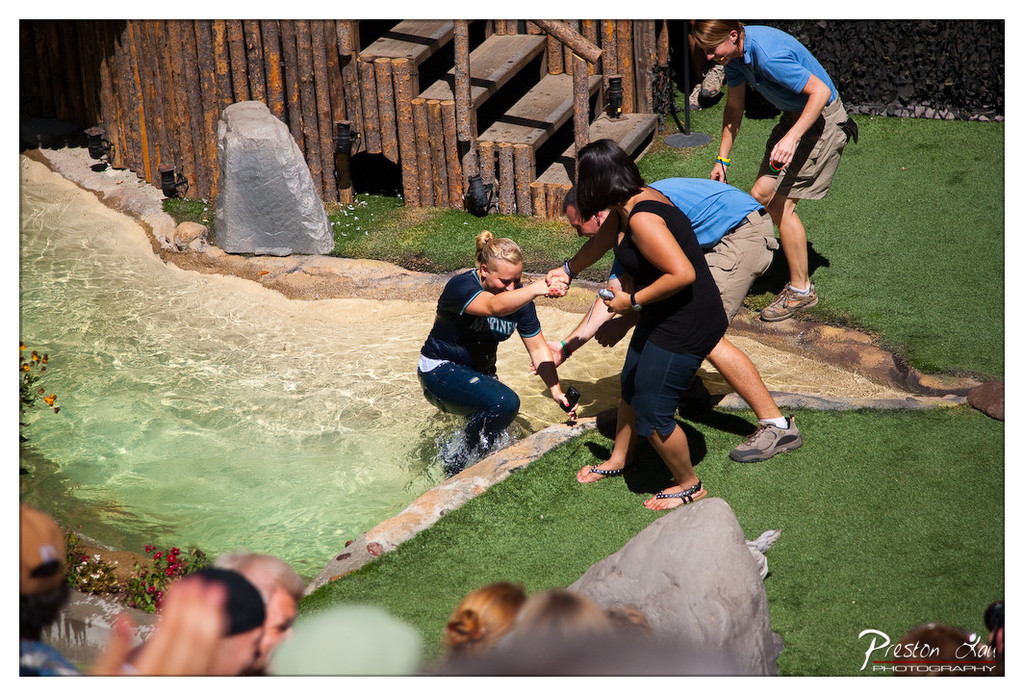

1. Overall Rating (0–10) — 7.0
This photograph captures a lively, candid moment of playful struggle at what appears to be a water attraction, where a woman is being pulled from a shallow pool by her teammates. The energy is palpable, and the scene feels authentic and unposed, reflecting the joy and camaraderie of a team-building activity. While the image successfully conveys motion and emotion, the composition’s slightly cluttered foreground and overexposed highlights slightly diminish its visual polish.
2. Composition (0–10) — 6.5
The diagonal line of the pool and the movement of the subjects create dynamic energy, though the cluttered foreground partially obstructs the view. The central action is well-framed, but the inclusion of audience heads in the lower edge weakens the focus.
3. Lighting (0–10) — 7.5
Bright, natural sunlight enhances the scene’s vibrancy and highlights the water’s movement. The high contrast between light and shadow adds depth, though some areas, particularly on the grass and faces, are slightly overexposed.
4. Color & Tone (0–10) — 7.0
The palette is lively, with rich greens from the artificial turf and clear turquoise water creating a refreshing contrast. The tones are balanced and warm, enhancing the outdoor, summery atmosphere.
5. Creativity (0–10) — 7.5
The photograph captures a spontaneous, emotionally charged moment with strong storytelling potential. The choice to include the audience in the foreground adds a layer of immersion, suggesting the scene is part of a larger event.
6. Technical Quality (0–10) — 7.5
Sharp focus on the central figures and clear detail in the water and surrounding textures indicate strong technical execution. The exposure is generally well-managed, though slight overexposure in highlights affects detail.
7. Emotional Impact (0–10) — 8.0
The image conveys excitement, teamwork, and playful determination. The viewer is drawn into the action, feeling the tension and laughter of the moment, making it emotionally engaging and relatable.
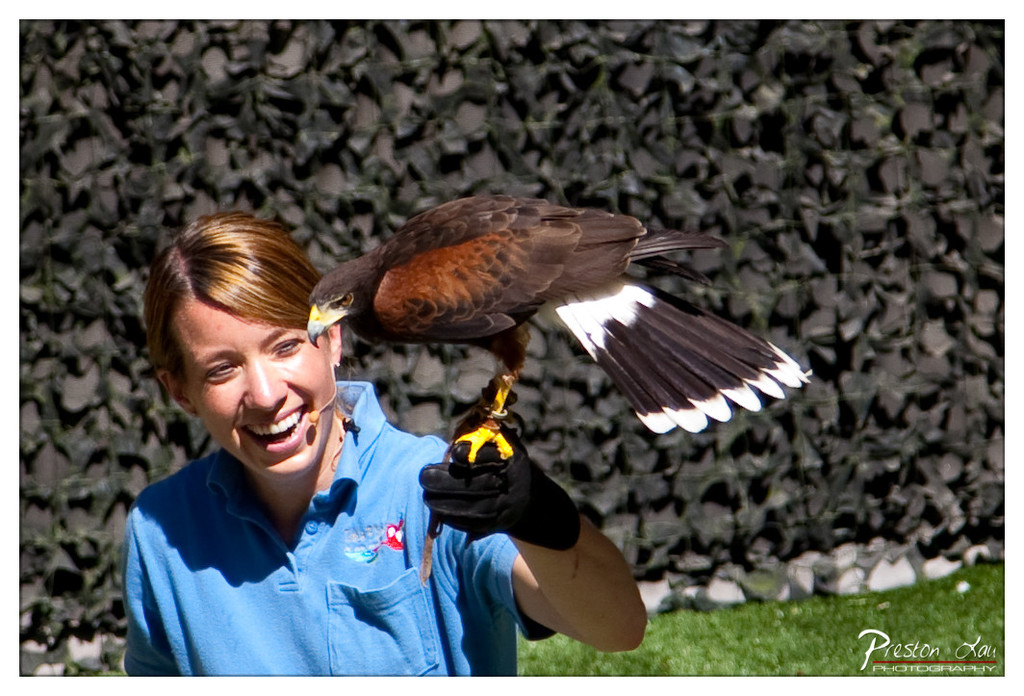

1. Overall Rating (0–10) — 7.5
This photograph captures a vibrant and joyful moment between a handler and a hawk, radiating warmth and connection. The subject’s genuine smile and the bird’s poised stance convey a sense of trust and mutual respect. While the background’s camouflage netting adds context, it slightly detracts from the scene’s natural elegance, and the harsh sunlight creates some overexposed highlights, limiting the image’s overall refinement.
2. Composition (0–10) — 7.0
The subject is well-centered, with the hawk’s outstretched wings creating a dynamic diagonal that draws the eye. The handler’s face and the bird’s body form a balanced triangular composition, though the cluttered background slightly disrupts visual harmony.
3. Lighting (0–10) — 7.5
Strong, direct sunlight highlights the subject with clarity and crispness, emphasizing the textures of the feathers and the handler’s expression. However, some areas, particularly the top of the head and the bird’s back, show slight overexposure, reducing detail in the highlights.
4. Color & Tone (0–10) — 8.0
The rich brown and white tones of the hawk contrast beautifully with the handler’s bright blue shirt and the green grass. The overall palette is vibrant and natural, with warm tones that enhance the scene’s lively mood.
5. Creativity (0–10) — 7.5
The image successfully captures a moment of interaction that feels both authentic and engaging. The choice to focus on the emotional connection between human and bird elevates the photograph beyond a simple wildlife portrait.
6. Technical Quality (0–10) — 8.0
The image is sharp and well-focused, with clear detail in both the subject and the background. The use of a telephoto lens helps isolate the subject from the surroundings, though the depth of field could be slightly more controlled.
7. Emotional Impact (0–10) — 8.5
The genuine joy on the handler’s face and the hawk’s calm posture evoke a strong sense of wonder and admiration. The image feels personal and uplifting, inviting the viewer to share in the moment’s warmth and trust.
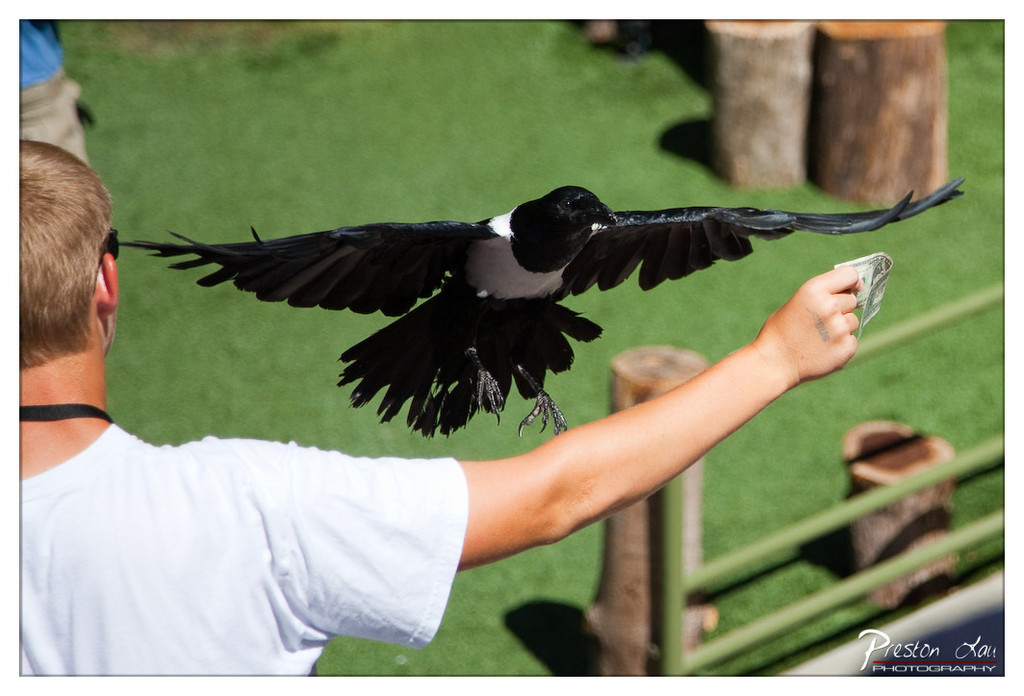

1. Overall Rating (0–10) — 7.5
This photograph captures a dynamic and engaging moment between a man and a magpie, freezing a fleeting interaction with clarity and energy. The bird’s outstretched wings and focused posture convey motion and intent, while the casual setting lends a sense of authenticity. Though the composition is strong, the slightly cluttered background and overexposed highlights slightly diminish the image’s overall polish.
2. Composition (0–10) — 7.0
The subject is well-placed, with the magpie centered in mid-flight and the man’s arm leading the eye into the frame. The diagonal lines of the outstretched limbs and wings create visual tension, though the background elements—particularly the log stumps—introduce minor distractions.
3. Lighting (0–10) — 7.5
Bright, natural daylight enhances the sharpness of the magpie’s feathers and the crispness of the scene. The high contrast highlights the bird’s black-and-white plumage, though some areas of the background appear slightly overexposed, losing detail.
4. Color & Tone (0–10) — 7.0
The vibrant green turf provides a vivid backdrop that contrasts effectively with the magpie’s dark feathers and the man’s white shirt. The color palette is natural and balanced, though the saturation feels slightly pushed, giving the greens a slightly artificial tone.
5. Creativity (0–10) — 8.0
The image captures a unique, spontaneous moment that blends human-animal interaction with a sense of narrative. The choice to freeze the bird mid-air adds drama and a feeling of immediacy, elevating it beyond a simple wildlife snapshot.
6. Technical Quality (0–10) — 8.0
Sharp focus on the magpie and clean details in the feathers and hand indicate strong technical execution. The fast shutter speed effectively freezes motion, and the depth of field isolates the subject well.
7. Emotional Impact (0–10) — 7.5
There’s a sense of trust and curiosity in the exchange, evoking a quiet connection between species. The viewer is drawn into the moment, wondering about the relationship between the man and the bird, making the image emotionally resonant and memorable.
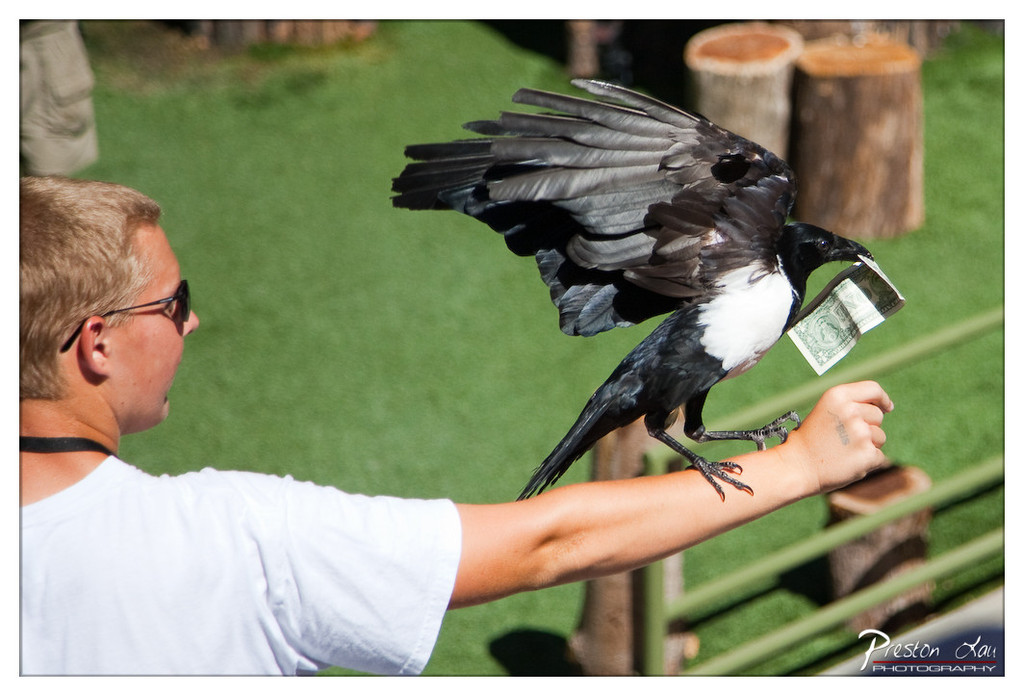

1. Overall Rating (0–10) — 7.5
This photograph captures a striking and dynamic moment of interaction between a man and a magpie, where the bird’s bold behavior and the crisp detail of its feathers create a sense of immediacy and wonder. The composition draws the eye naturally to the bird’s outstretched wing and the money it carries, suggesting a narrative of intelligence and trust. While the background is slightly distracting with its artificial turf and wooden stumps, the central action is compelling and well-framed, making the image both engaging and memorable.
2. Composition (0–10) — 7.0
The subject is well-placed along the diagonal, creating a sense of motion and direction. The man’s outstretched arm acts as a natural leading line, guiding the viewer’s eye toward the bird. However, the background elements, particularly the blurred log stumps and the railing, introduce visual clutter that slightly detracts from the focus.
3. Lighting (0–10) — 8.0
Bright, natural daylight illuminates the scene evenly, highlighting the texture and sheen of the magpie’s feathers. The strong contrast between the bird’s black and white plumage and the green background enhances visibility and adds depth.
4. Color & Tone (0–10) — 7.5
The palette is vibrant yet balanced, with the deep black and white of the magpie standing out against the artificial green of the turf. The green tones are slightly oversaturated, but the overall effect is lively and engaging without appearing unnatural.
5. Creativity (0–10) — 8.5
The image captures a rare and intriguing moment—magpies are known for their intelligence and tendency to collect shiny objects, so the inclusion of the dollar bill adds a layer of narrative and humor. The photographer has seized a spontaneous, almost theatrical interaction, transforming a simple moment into a story of curiosity and connection.
6. Technical Quality (0–10) — 8.0
The focus is sharp on the bird and the man’s arm, capturing fine details such as the texture of the feathers and the creases in the bill. The shutter speed is fast enough to freeze motion, particularly in the bird’s wing, resulting in a clean and crisp image.
7. Emotional Impact (0–10) — 8.0
The image evokes a sense of awe and amusement, drawing the viewer into a moment of unexpected connection between human and animal. The magpie’s boldness and the man’s calm demeanor create a feeling of trust and mutual curiosity, making the scene both entertaining and emotionally resonant.
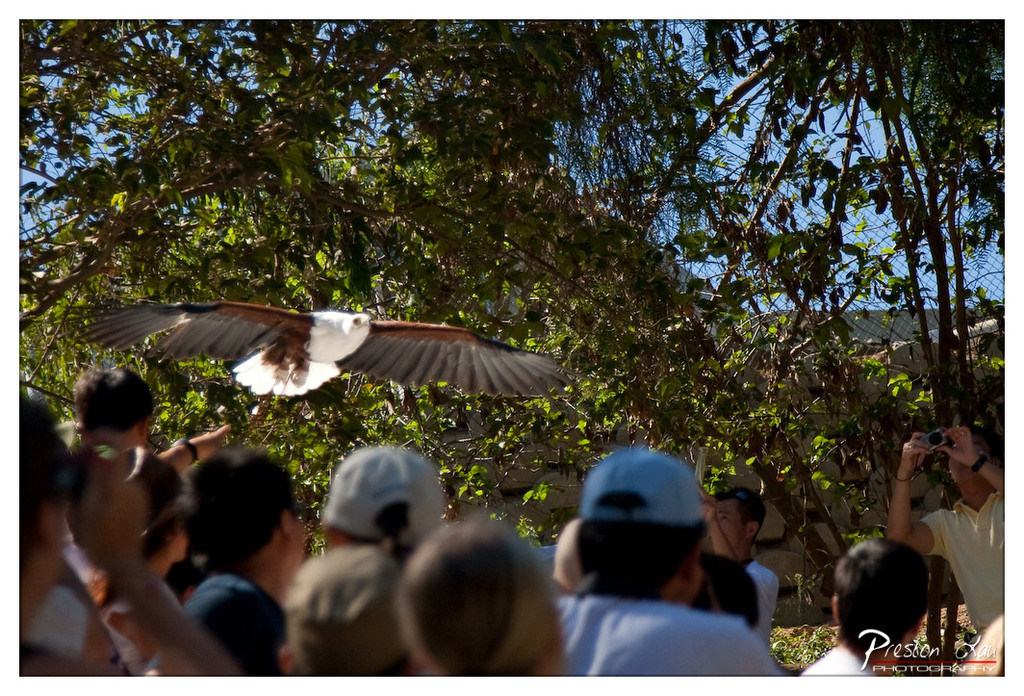

1. Overall Rating (0–10) — 7.0
This photograph captures a dynamic moment of a bird in flight, likely during a live demonstration, with the audience’s attention fixed on the spectacle. The motion of the bird, frozen mid-glide, conveys energy and grace, while the natural backdrop of dense greenery adds depth and context. While the image is compelling in its immediacy and subject matter, the slightly cluttered foreground and uneven lighting reduce its overall visual polish.
2. Composition (0–10) — 6.5
The bird is well-placed along the diagonal, guiding the eye through the frame, but the overlapping heads in the foreground disrupt visual flow and distract from the central subject. A tighter crop or higher vantage point could have improved focus.
3. Lighting (0–10) — 6.0
Bright, natural sunlight creates strong contrast between the sunlit bird and the shadowed foliage, enhancing texture and movement. However, the harsh overhead light results in deep shadows and blown-out highlights, reducing detail in key areas.
4. Color & Tone (0–10) — 6.5
The rich greens of the trees contrast sharply with the white and brown plumage of the bird, creating a natural palette. The slightly warm tone enhances the outdoor atmosphere, though the color balance feels slightly unbalanced, leaning toward oversaturation in the foliage.
5. Creativity (0–10) — 7.5
The image successfully captures a fleeting, real-world moment with narrative potential—perhaps a wildlife show or conservation event. The juxtaposition of the wild bird and the captivated audience adds storytelling depth and a sense of shared experience.
6. Technical Quality (0–10) — 7.0
The bird is captured with sufficient sharpness and clarity, indicating a fast shutter speed. However, focus is slightly soft on the bird’s wings, and the background is unevenly lit, affecting overall crispness.
7. Emotional Impact (0–10) — 7.0
The photograph evokes a sense of awe and wonder, drawing the viewer into the shared experience of witnessing nature in motion. The crowd’s engagement reinforces the emotional resonance, making the moment feel both personal and universal.
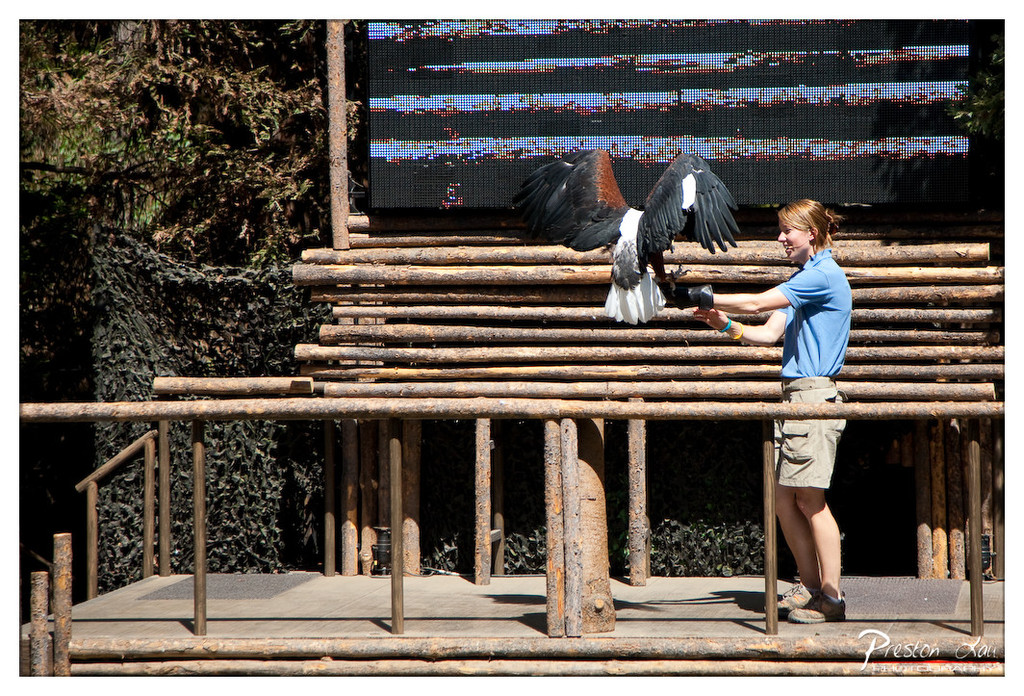

1. Overall Rating (0–10) — 7.0
This photograph captures a dynamic moment of interaction between a handler and a large bird of prey, likely during a zoo or wildlife demonstration. The natural lighting and candid composition lend authenticity to the scene, while the bird’s outstretched wings convey motion and power. The juxtaposition of the modern LED screen against the rustic wooden platform creates a subtle tension between nature and technology, though the background screen slightly distracts from the central action.
2. Composition (0–10) — 6.5
The subject is well-placed along the right third of the frame, creating a balanced yet dynamic composition. The horizontal logs and railing provide strong leading lines, guiding the eye toward the bird and handler. However, the cluttered background and the digital screen in the upper center introduce visual noise, slightly disrupting the focus.
3. Lighting (0–10) — 8.0
Bright, natural sunlight enhances the scene’s clarity and detail, casting sharp shadows that emphasize the bird’s form and the texture of the wooden structure. The light direction from the upper left adds dimension and depth, highlighting the bird’s feathers and the handler’s gesture.
4. Color & Tone (0–10) — 6.5
The palette is dominated by earthy browns and greens, punctuated by the bright blue of the handler’s shirt and the stark white and black of the bird. The LED screen introduces a contrasting cool blue and red hue, which, while visually interesting, slightly disrupts the natural harmony of the scene.
5. Creativity (0–10) — 7.0
The image successfully captures a rare, engaging moment of human-animal interaction, with the bird’s wingspan creating a dramatic focal point. The inclusion of the digital screen adds a modern, almost surreal layer, suggesting a commentary on wildlife presentation in the digital age.
6. Technical Quality (0–10) — 8.0
The image is sharp and well-exposed, with precise focus on the bird and handler. The detail in the feathers and textures of the wood is clear, and the dynamic range handles the bright sunlight well without losing detail in highlights or shadows.
7. Emotional Impact (0–10) — 7.5
The photograph evokes a sense of awe and connection, capturing both the majesty of the bird and the calm confidence of the handler. The viewer is drawn into the moment, feeling the energy of the performance and the trust between human and animal.
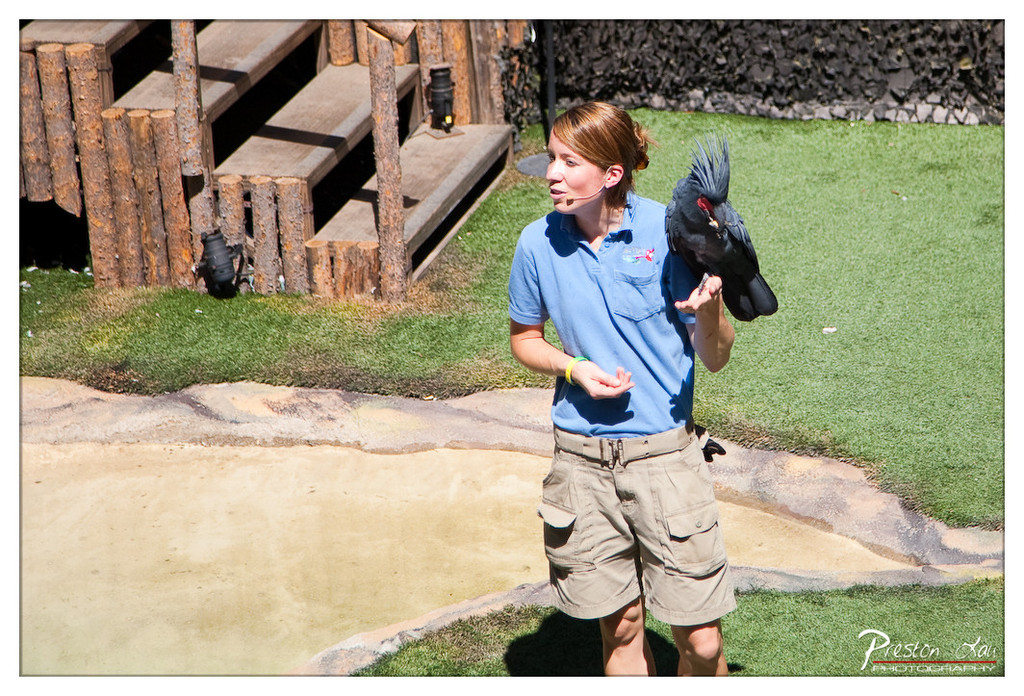

1. Overall Rating (0–10) — 7.0
This image captures a lively and engaging moment during a zoo presentation, where a handler shares a quiet connection with a striking black cockatoo. The natural lighting and candid posture lend authenticity to the scene, though the composition feels slightly unbalanced by the cluttered background. The focus on the interaction between human and bird creates a compelling narrative, even as the surrounding environment distracts from the central subject.
2. Composition (0–10) — 6.0
The subject is well-framed but slightly off-center, with the wooden structure on the left creating visual tension. The foreground sand and uneven terrain add depth but also distract from the main focus.
3. Lighting (0–10) — 8.0
Bright, natural sunlight highlights the subject clearly, creating strong contrast and defining the textures of the bird’s feathers and the handler’s clothing. The shadows are sharp but not overly harsh.
4. Color & Tone (0–10) — 7.0
The vibrant green grass and deep black of the cockatoo create a strong visual contrast against the muted earth tones of the handler’s uniform. The color palette feels natural and balanced, with a slight warmth enhancing the outdoor atmosphere.
5. Creativity (0–10) — 7.0
The photograph captures a unique, real-life moment with expressive potential, emphasizing the relationship between human and animal. While not highly stylized, it conveys a sense of authenticity and storytelling.
6. Technical Quality (0–10) — 8.0
The image is sharp and well-focused, with clear details visible in both the subject and the background. The exposure is accurate, and the depth of field effectively isolates the main subject.
7. Emotional Impact (0–10) — 7.5
There’s a quiet warmth in the handler’s attentive expression and the bird’s calm posture, evoking a sense of trust and mutual respect. The viewer is drawn into the moment, feeling a personal connection to the gentle interaction.
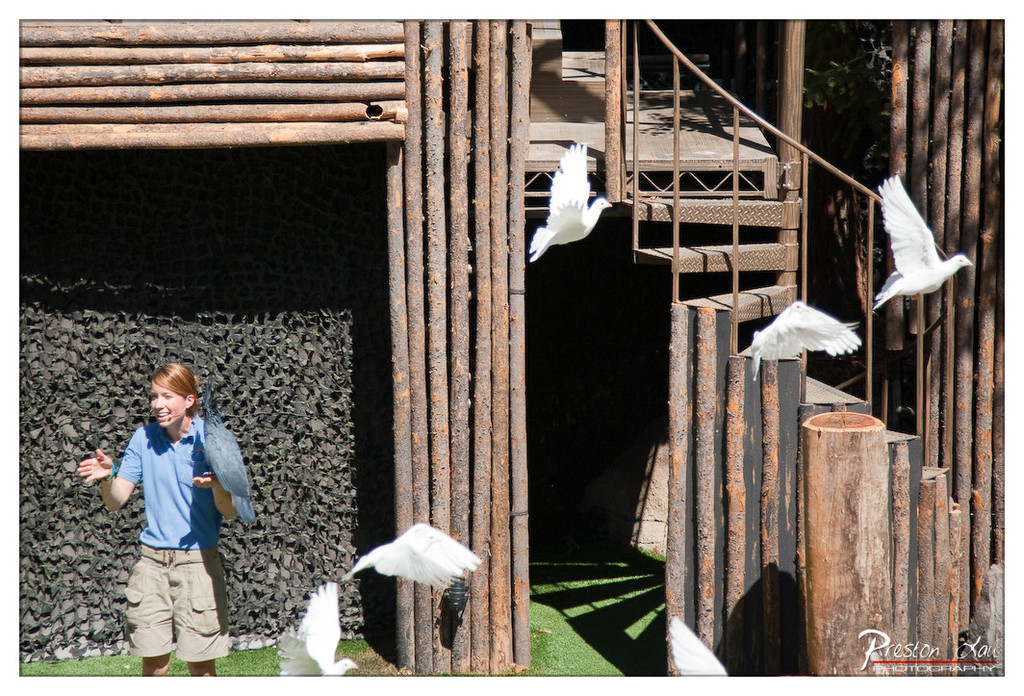

1. Overall Rating (0–10) — 7.0
This photograph captures a dynamic moment of interaction between a handler and a flock of white birds, conveying energy and motion with a sense of natural grace. The contrast between the stillness of the subject and the flurry of flight creates a compelling visual rhythm. While the composition is strong, the image's emotional resonance is slightly muted by the overly bright lighting, which flattens some of the textures and depth.
2. Composition (0–10) — 7.5
The subject is well-placed off-center, allowing space for the birds to fly into the frame, enhancing the sense of movement. The vertical lines of the wooden structure guide the eye and frame the action, though the right side feels slightly crowded.
3. Lighting (0–10) — 6.5
Harsh, direct sunlight creates strong shadows and overexposed highlights on the birds, reducing detail in their wings. The lighting emphasizes motion but sacrifices tonal richness and depth in the darker areas.
4. Color & Tone (0–10) — 7.0
The palette is dominated by natural earth tones—browns, greens, and the crisp white of the birds—which creates a harmonious, organic feel. However, the high contrast and slightly washed-out whites reduce the vibrancy of the scene.
5. Creativity (0–10) — 7.5
The image successfully captures a fleeting, lively moment with a clear narrative—human and animal in motion. The interplay between stillness and movement, along with the architectural elements, adds visual interest and suggests a story beyond the frame.
6. Technical Quality (0–10) — 7.0
The image is sharp and well-focused, with clear detail in the subject and the birds in flight. The fast shutter speed effectively freezes motion, though some of the birds show slight motion blur at the edges.
7. Emotional Impact (0–10) — 6.5
The scene evokes a sense of joy and connection with nature, but the intensity of the light and the lack of subtle emotional cues in the subject’s expression keep the viewer from fully engaging with the moment.
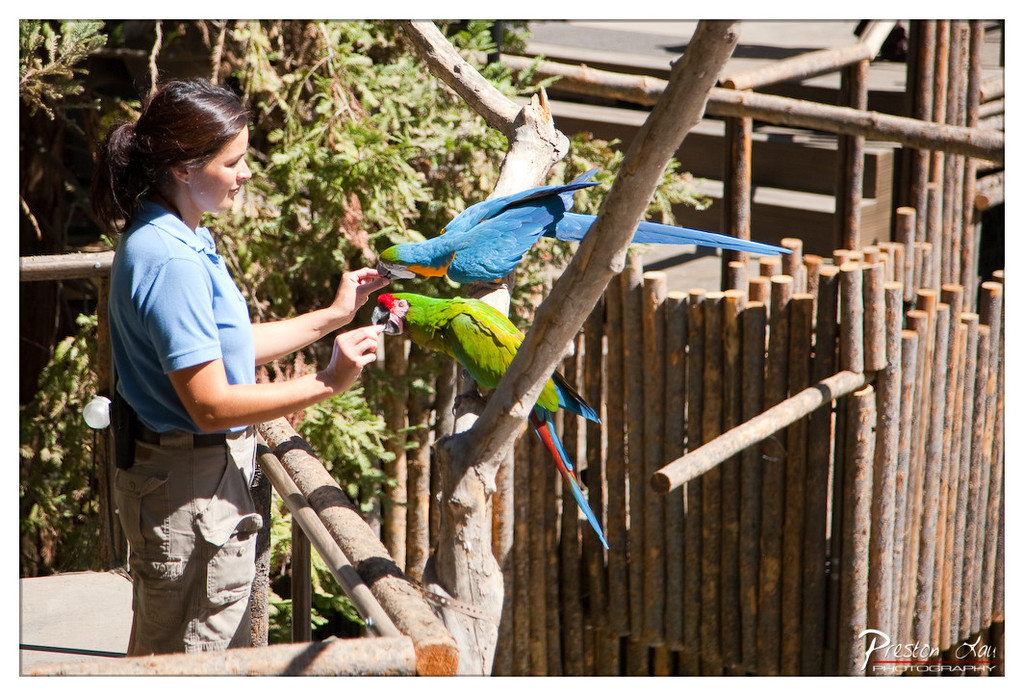

1. Overall Rating (0–10) — 7.5
This photograph captures a serene and engaging moment between a caretaker and two vibrant macaws, blending human connection with the natural world. The rich colors of the birds contrast beautifully with the earthy tones of the enclosure, creating a visually dynamic scene. While the composition is strong and the lighting enhances the moment, a tighter framing and more intentional use of depth could elevate the image from a pleasant snapshot to a compelling narrative.
2. Composition (0–10) — 7.0
The subject is well-placed, with the woman and parrots forming a natural diagonal line that guides the eye through the frame. However, the background elements—particularly the wooden poles—create a slightly cluttered effect that competes for attention.
3. Lighting (0–10) — 8.0
Bright, natural sunlight enhances the vividness of the parrots’ plumage and casts soft shadows that add depth. The light is directional, suggesting midday sun, which highlights the textures of feathers and skin without creating harsh glare.
4. Color & Tone (0–10) — 8.5
The palette is rich and harmonious, with the electric blue and green of the macaws standing out against the warm browns and muted greens of the environment. The contrast between the bright birds and the subdued background creates a visually striking effect.
5. Creativity (0–10) — 7.5
The image tells a quiet story of care and interaction, capturing a genuine moment of connection. While not radically original in concept, the execution and timing demonstrate a keen eye for the narrative within a simple scene.
6. Technical Quality (0–10) — 8.0
The focus is sharp on the subjects, with fine detail visible in the feathers and facial features. The exposure is well-balanced, and the image is free of noticeable noise or artifacts.
7. Emotional Impact (0–10) — 8.0
There is a palpable sense of calm and trust in the interaction, evoking warmth and empathy. The viewer is drawn into the gentle exchange, feeling a connection to both the woman and the birds.
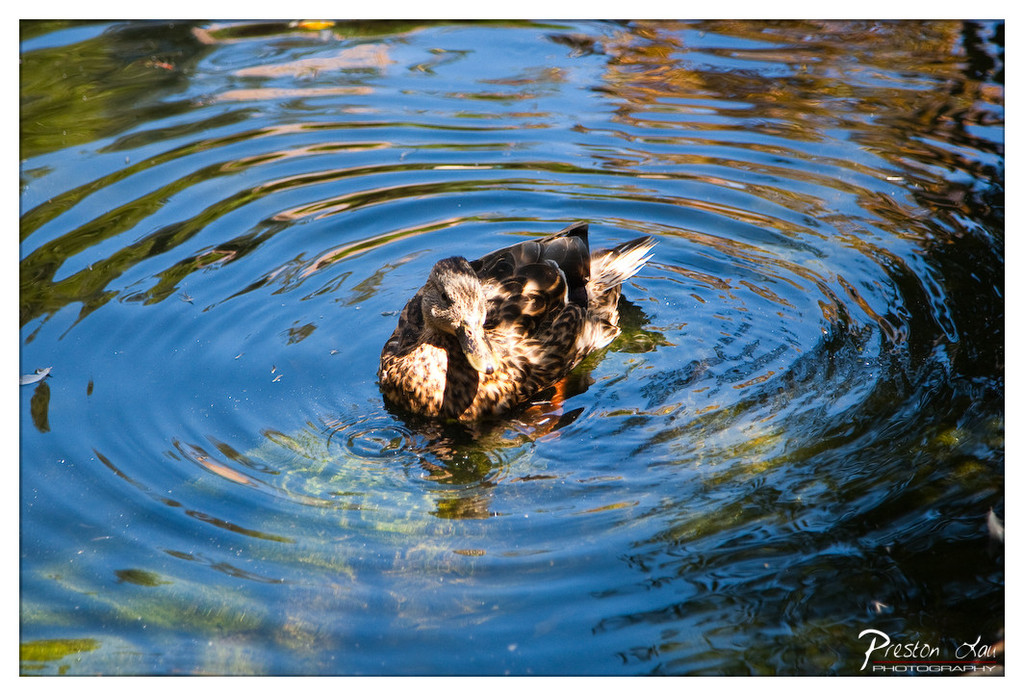

1. Overall Rating (0–10) — 8.0
This photograph captures a serene moment of a duck gently gliding through rippling water, its feathers catching the warm sunlight in a way that feels both intimate and timeless. The concentric ripples create a natural frame around the subject, drawing the eye inward with a sense of quiet motion. While the image is visually rich and emotionally evocative, a slightly more deliberate composition could enhance its narrative depth.
2. Composition (0–10) — 7.5
The duck is centered within the circular ripples, creating a strong focal point and a sense of harmony. The use of natural framing through the water’s movement adds depth, though the slight tilt in the horizon subtly disrupts the balance.
3. Lighting (0–10) — 9.0
The warm, golden light highlights the duck’s mottled plumage and casts soft reflections on the water’s surface, enhancing texture and mood. The direction of the light—likely late afternoon—adds a golden glow that amplifies the scene’s peaceful atmosphere.
4. Color & Tone (0–10) — 8.5
The rich, saturated blues of the water contrast beautifully with the warm browns and golds of the duck’s feathers. The color palette is cohesive and enhances the natural beauty of the moment, with a well-balanced contrast that feels both vivid and natural.
5. Creativity (0–10) — 8.0
The photographer captures a simple moment with a strong sense of visual storytelling, using the ripples as a dynamic element that adds motion and rhythm. The choice to freeze the action at this precise moment gives the image a poetic quality, elevating it beyond mere documentation.
6. Technical Quality (0–10) — 9.0
The image is sharp and well-focused, with excellent detail in the duck’s feathers and the water’s texture. The exposure is balanced, preserving highlights and shadows without clipping, and the depth of field appropriately isolates the subject.
7. Emotional Impact (0–10) — 8.5
There is a strong sense of tranquility and connection to nature, evoked through the soft light, gentle movement, and the duck’s calm demeanor. The viewer is drawn into a quiet, meditative space, making the image emotionally resonant and memorable.
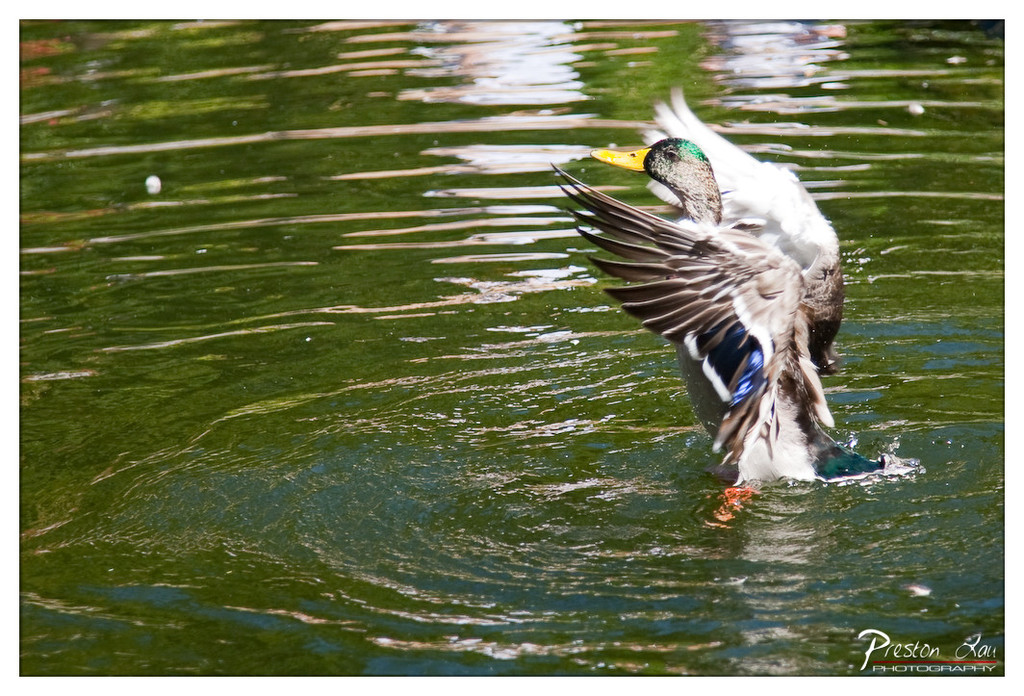

1. Overall Rating (0–10) — 7.5
This photograph captures a moment of dynamic motion, freezing a mallard duck mid-flap as it takes flight from the water. The interplay of light on the ripples and the bird’s vibrant green head creates a vivid, lively scene. While the energy of the moment is compelling, the image slightly loses impact due to a lack of deeper tonal contrast and a composition that feels just a bit too centered, reducing its visual tension.
2. Composition (0–10) — 6.5
The duck is well-placed off-center, following the rule of thirds, which guides the eye across the frame. However, the expansive water background feels underutilized, and the slight tilt of the frame detracts from a more balanced, intentional feel.
3. Lighting (0–10) — 8.0
Bright, natural sunlight enhances the scene, highlighting the duck’s iridescent feathers and creating sparkling reflections on the water. The light is directional and rich, adding depth and texture to the ripples and the bird’s plumage.
4. Color & Tone (0–10) — 7.5
The palette is dominated by rich greens and deep blues, with the duck’s vivid green head and yellow beak providing strong focal points. The tones are well-saturated without appearing over-processed, though the green water slightly overwhelms the image’s overall tonal balance.
5. Creativity (0–10) — 8.0
The image successfully captures a fleeting, natural moment with a strong sense of motion. The photographer’s ability to freeze action while maintaining a sense of fluidity demonstrates both technical skill and artistic awareness.
6. Technical Quality (0–10) — 8.5
Sharp focus on the duck, with excellent detail in the feathers and water droplets, indicates a high shutter speed and precise control. The image is clean, well-exposed, and free of distracting noise.
7. Emotional Impact (0–10) — 7.0
The photograph evokes a sense of energy and freedom, capturing the quiet drama of a bird in motion. While not deeply introspective, it resonates with the viewer through its immediacy and vitality.
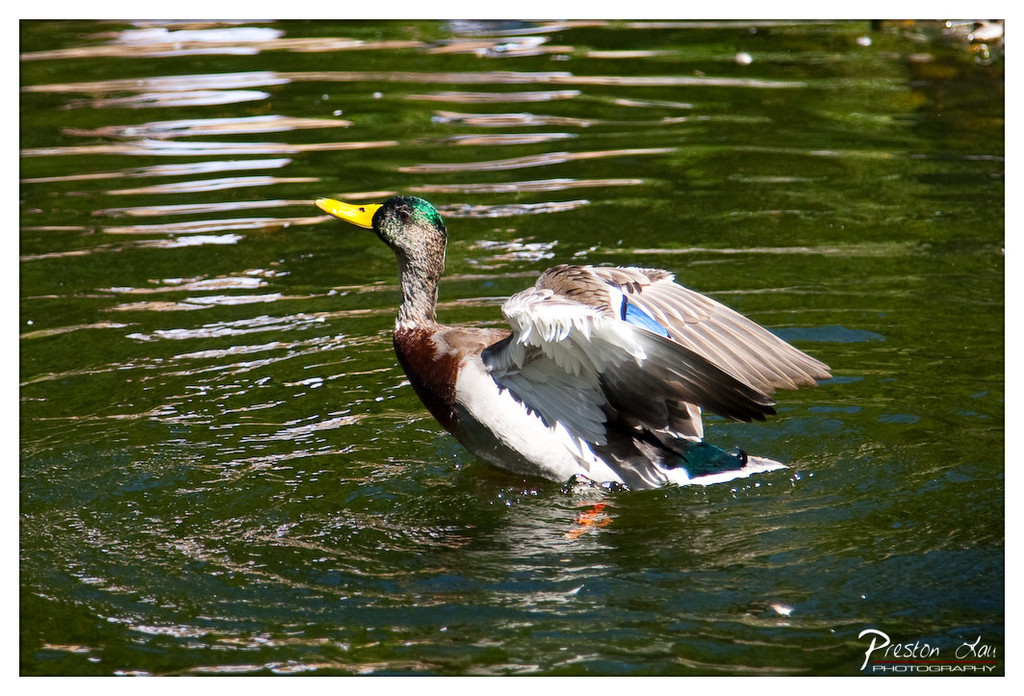

1. Overall Rating (0–10) — 7.5
This image captures a moment of natural grace, with a male mallard mid-movement on a sunlit pond, its wings partially unfurled in a display of motion and vitality. The rich, iridescent green of the duck’s head contrasts beautifully with the dappled sunlight on the water, creating a scene that feels both lively and serene. While the composition is strong and the moment well-timed, the slightly cluttered water surface and minor distractions in the background prevent it from achieving a more refined, gallery-ready aesthetic.
2. Composition (0–10) — 7.0
The duck is well-placed off-center, creating a dynamic diagonal that guides the eye across the frame. The open space on the left allows the viewer to anticipate the bird’s movement, enhancing the sense of motion. However, the water’s surface, while textured, slightly competes for attention, softening the focus on the subject.
3. Lighting (0–10) — 8.0
Bright, natural sunlight enhances the duck’s vivid plumage and creates sparkling reflections on the water’s surface. The light is directional, highlighting the contours of the bird’s body and wings, while the ripples add a luminous, almost painterly quality to the scene.
4. Color & Tone (0–10) — 8.0
The palette is rich and balanced, with deep greens and browns in the water complementing the duck’s emerald head and warm chestnut tones. The bright yellow bill provides a striking accent, and the tonal contrast between light and shadow adds depth and vibrancy.
5. Creativity (0–10) — 7.5
The photograph captures a fleeting, authentic moment in nature with a clear artistic sensibility. The choice to freeze the duck mid-flap adds a narrative quality, transforming a simple wildlife scene into a story of movement and life.
6. Technical Quality (0–10) — 8.5
The image is sharp and detailed, with precise focus on the duck’s head and wings. The exposure is well-managed, preserving highlights in the water and maintaining detail in the shadows. The shallow depth of field effectively isolates the subject from the background.
7. Emotional Impact (0–10) — 7.0
The image evokes a sense of tranquility and wonder, inviting the viewer to pause and appreciate the beauty of a common creature in motion. The combination of movement, light, and natural detail creates a quiet but powerful emotional resonance.
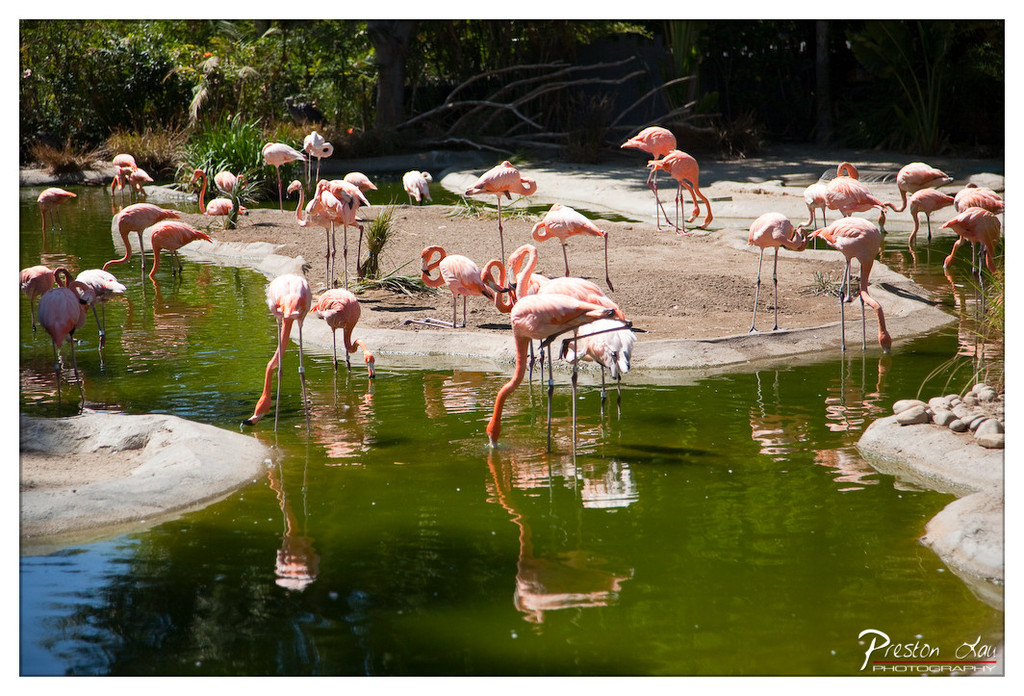

1. Overall Rating (0–10) — 7.5
This photograph captures a vibrant and harmonious scene of flamingos in their naturalistic habitat, exuding a sense of calm and grace. The vivid pink hues of the birds contrast beautifully with the emerald green water, creating a visually striking composition that feels both lively and serene. While the image is rich in color and detail, the slightly overexposed highlights in the background detract from its overall subtlety, preventing it from achieving full artistic cohesion.
2. Composition (0–10) — 8.0
The birds are arranged across the frame with a natural balance, leading the eye from the foreground through the midground to the back. The diagonal flow of the water and the placement of the flamingos create a sense of depth and movement, while the reflection in the water adds symmetry and visual interest.
3. Lighting (0–10) — 8.0
Bright, direct sunlight enhances the vividness of the flamingos’ feathers and creates strong, clear reflections in the water. The light is well-distributed, with natural highlights on the birds and a soft glow on the water’s surface, though some areas in the background are slightly washed out.
4. Color & Tone (0–10) — 9.0
The palette is rich and saturated, with the brilliant pink of the flamingos standing out against the deep green of the water and the earthy tones of the landscape. The color harmony is strong, and the tonal contrast between light and shadow adds dimension and visual appeal.
5. Creativity (0–10) — 7.5
The image captures a compelling moment in a natural setting, emphasizing the beauty of wildlife in a serene environment. While the concept is straightforward, the photographer’s skill in capturing the interplay of light, color, and reflection elevates the scene beyond mere documentation into a visually poetic moment.
6. Technical Quality (0–10) — 8.5
The image is sharp and clear, with fine detail visible in the feathers and reflections. The focus is well-managed, and the exposure is largely balanced, though minor overexposure in the background slightly compromises technical perfection.
7. Emotional Impact (0–10) — 8.0
The photograph evokes a sense of tranquility and wonder, inviting the viewer to pause and appreciate the elegance of the flamingos in their habitat. The vibrant colors and serene setting create a positive, uplifting mood that resonates with a deep appreciation for nature.
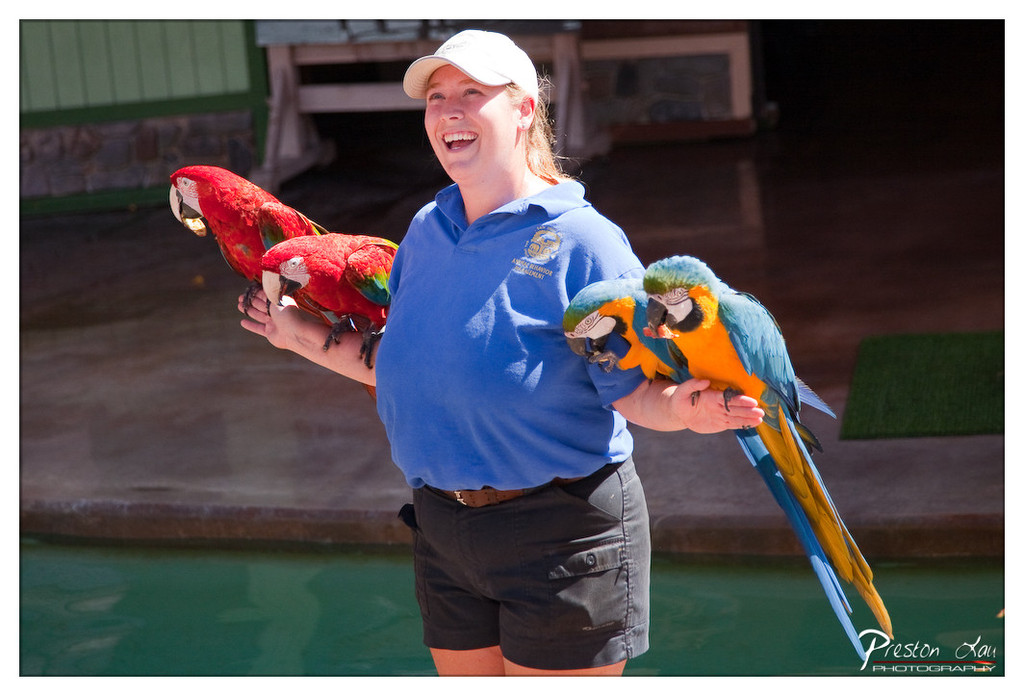

1. Overall Rating (0–10) — 8.0
This photograph radiates joy and connection, capturing a moment of genuine delight between a handler and her vibrant parrots. The subject’s broad smile and the birds’ confident perches create a lively, engaging scene that feels both spontaneous and professionally staged. While the background remains slightly distracting, the vivid colors and emotional warmth elevate the image into a compelling portrait of human-animal interaction.
2. Composition (0–10) — 7.5
The subject is well-centered with a slight off-center placement that adds dynamism, while the parrots balance the frame across both arms. The shallow depth of field effectively isolates the subject, though the background elements—particularly the green mat and structural details—slightly disrupt visual harmony.
3. Lighting (0–10) — 8.5
Bright, natural sunlight enhances the vividness of the parrots’ plumage and the woman’s cheerful expression. The light falls evenly, creating soft shadows that add dimension without overpowering the scene.
4. Color & Tone (0–10) — 9.0
The rich, saturated colors of the macaws—red, blue, and yellow—contrast beautifully with the blue shirt and green background. The tonal balance is warm and inviting, enhancing the overall sense of vitality and happiness.
5. Creativity (0–10) — 8.0
The image captures a unique and lively moment that goes beyond a simple animal portrait. The combination of expressive human emotion and the bold visual presence of the birds creates a narrative that feels both personal and universally appealing.
6. Technical Quality (0–10) — 8.5
Sharp focus on the subject, clean detail in the feathers and facial features, and well-managed exposure contribute to a technically strong image. The watermark is unobtrusive and professionally placed.
7. Emotional Impact (0–10) — 9.0
The infectious laughter and confident posture of the handler evoke a sense of trust and joy, drawing the viewer into a moment of shared connection with nature. The image resonates with warmth and authenticity.
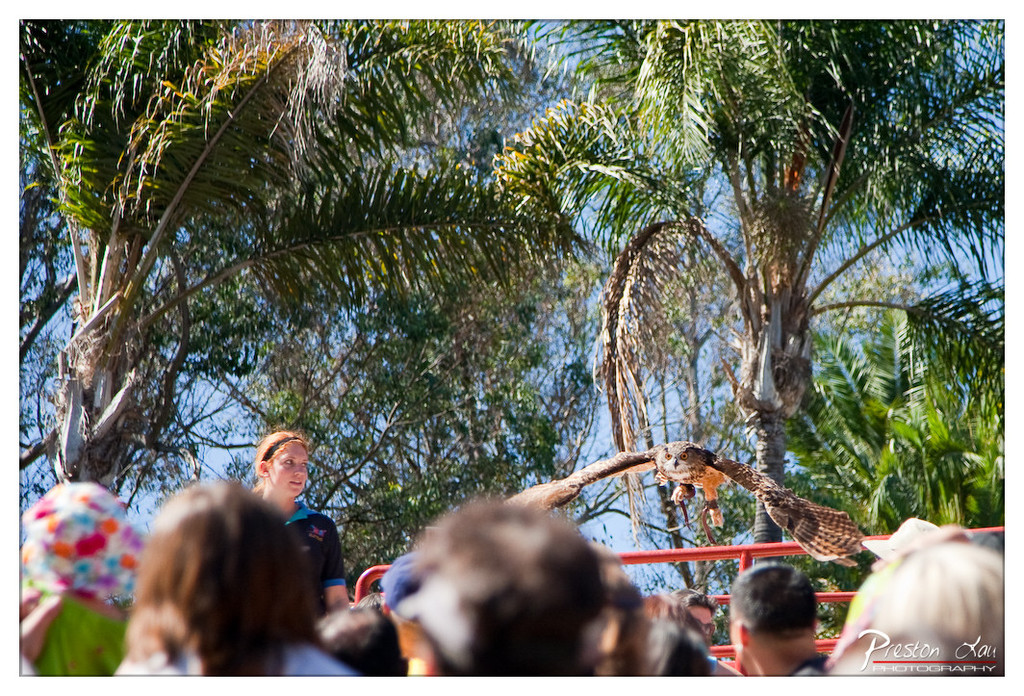

1. Overall Rating (0–10) — 6.8
This photograph captures a dynamic moment of a bird of prey in flight during what appears to be a live wildlife demonstration, with a crowd observing in the foreground. The energy of the scene is palpable, and the natural setting enhances the authenticity of the moment. While the composition is slightly unbalanced and the lighting is harsh, the image succeeds in conveying the excitement and immediacy of a live animal presentation—its power lies in its spontaneity and narrative potential.
2. Composition (0–10) — 5.5
The framing is awkward, with the crowd in the foreground partially obstructing the view and the owl’s flight path cutting diagonally across the frame. The trainer is positioned off-center, and the palm trees create a busy background that distracts from the main action.
3. Lighting (0–10) — 6.0
Harsh midday sunlight creates strong highlights and deep shadows, particularly on the bird’s feathers and the woman’s face. While the bright conditions ensure clarity, they reduce tonal subtlety and add contrast that flattens some of the scene’s depth.
4. Color & Tone (0–10) — 6.5
The image features vibrant greens from the palm trees and a bright blue sky, which contrast well with the warm browns of the owl. However, the overall color balance leans slightly cool, and some areas are oversaturated, particularly the red railing and the sky.
5. Creativity (0–10) — 7.0
The photographer captured a rare, action-filled moment that tells a story—of wildlife, education, and human connection. The low angle and candid feel lend a sense of immediacy, making the scene feel alive rather than staged.
6. Technical Quality (0–10) — 7.5
The image is sharp in focus, particularly on the owl and the trainer, and the high resolution preserves fine feather detail. The exposure is generally well-managed despite the challenging lighting conditions.
7. Emotional Impact (0–10) — 7.0
There’s a sense of awe and anticipation in the crowd’s posture and the bird’s outstretched wings, which evokes a feeling of wonder and respect for nature. The moment feels authentic and stirring, drawing the viewer into the experience.
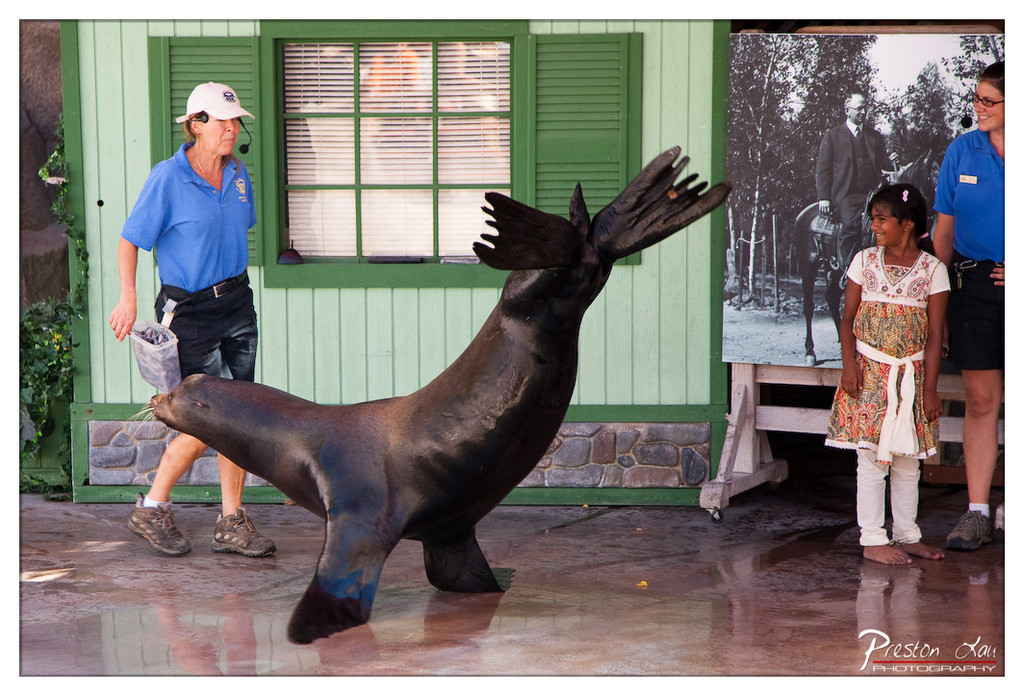

1. Overall Rating (0–10) — 7.0
This photograph captures a lively and engaging moment during a sea lion performance, where human interaction and animal behavior converge in a shared space of play and training. The dynamic posture of the sea lion, combined with the expressions of the handlers and the young girl, creates a sense of energy and connection. While the image is well-composed and emotionally resonant, the slightly cluttered background and flat lighting prevent it from achieving a more refined visual impact.
2. Composition (0–10) — 7.5
The sea lion is dynamically framed in motion, with its raised flipper drawing the eye toward the center. The placement of the trainer and the girl on either side creates a balanced narrative structure, guiding the viewer through the scene. However, the large historical photograph on the right slightly distracts from the main action, creating a visual imbalance.
3. Lighting (0–10) — 6.0
The lighting is bright and even, likely from overhead stadium lights, which clearly illuminates the scene. However, the flatness of the light minimizes shadows and depth, giving the image a slightly sterile quality. The reflections on the wet floor add a subtle layer of texture but do not significantly enhance the mood.
4. Color & Tone (0–10) — 6.5
The dominant green of the building and the blue of the uniforms provide a cohesive color palette, while the dark tones of the sea lion create contrast. The overall tone is natural but subdued, with a slight coolness that dampens the warmth of the human interaction.
5. Creativity (0–10) — 7.0
The photograph captures a unique and authentic moment of animal training and audience engagement. The inclusion of the young girl adds a layer of innocence and wonder, making the scene more relatable and emotionally layered.
6. Technical Quality (0–10) — 7.5
The image is sharp and clear, with well-defined details in the sea lion’s fur and the subjects’ expressions. The focus is precise, and the exposure is well-balanced, though some areas of the background are slightly overexposed.
7. Emotional Impact (0–10) — 7.5
The photograph evokes a sense of joy and fascination, particularly through the girl’s bright smile and the sea lion’s playful pose. The shared moment between animal and human suggests a connection that is both entertaining and heartwarming, resonating with viewers on an emotional level.
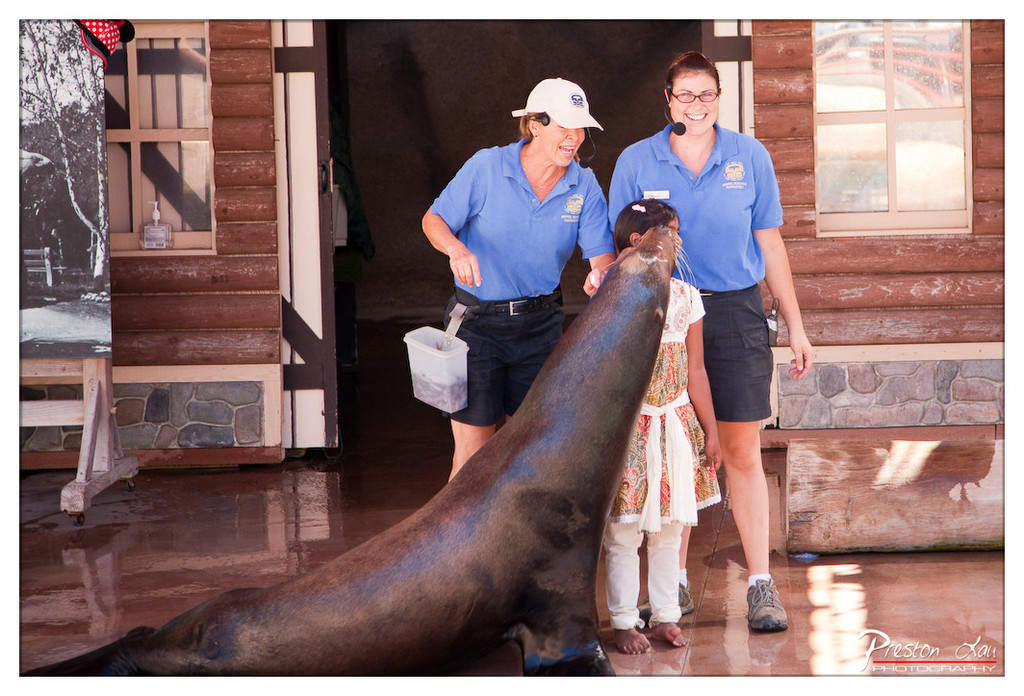

1. Overall Rating (0–10) — 7.0
This photograph captures a lively and heartwarming moment between a sea lion, two trainers, and a young child, evoking a sense of connection and wonder. The interaction feels authentic and joyful, with the sea lion’s extended posture and the smiling faces creating a narrative of trust and performance. While the scene is engaging, the composition is slightly cluttered, and the lighting, though bright, lacks dramatic depth, preventing the image from feeling fully polished.
2. Composition (0–10) — 6.5
The sea lion’s diagonal form draws the eye across the frame, creating movement, but the background elements—such as the sign and open doorway—distract from the central interaction. The child is slightly off-center, and the positioning of the trainers creates a sense of imbalance, though the overall framing captures the story effectively.
3. Lighting (0–10) — 6.0
The scene is evenly lit with bright, natural daylight, which clearly illuminates the subjects and enhances the sense of openness. However, the light is flat and lacks directional warmth, resulting in a slightly sterile quality that diminishes the emotional richness of the moment.
4. Color & Tone (0–10) — 6.5
The dominant blue of the trainers’ uniforms creates a cohesive color theme, complemented by the warm brown tones of the wooden structure. The child’s colorful dress adds a pop of vibrancy, but the overall palette is somewhat muted, with a slight cool cast that softens the image’s warmth.
5. Creativity (0–10) — 7.0
The image tells a compelling story of human-animal interaction, with a candid and spontaneous feel that sets it apart from staged wildlife photography. The inclusion of the child adds a layer of innocence and wonder, enhancing the narrative beyond a simple performance.
6. Technical Quality (0–10) — 7.5
The photograph is sharp and well-focused, particularly on the sea lion and the people in the foreground. The wet floor reflects light subtly, adding texture without distracting. The clarity of the details—such as the microphones, uniforms, and expressions—shows strong technical execution.
7. Emotional Impact (0–10) — 7.5
The genuine smiles and the sea lion’s attentive posture evoke a sense of joy and connection. The image resonates emotionally by capturing a moment of shared delight, inviting the viewer to feel the warmth of the interaction and the wonder of the encounter.
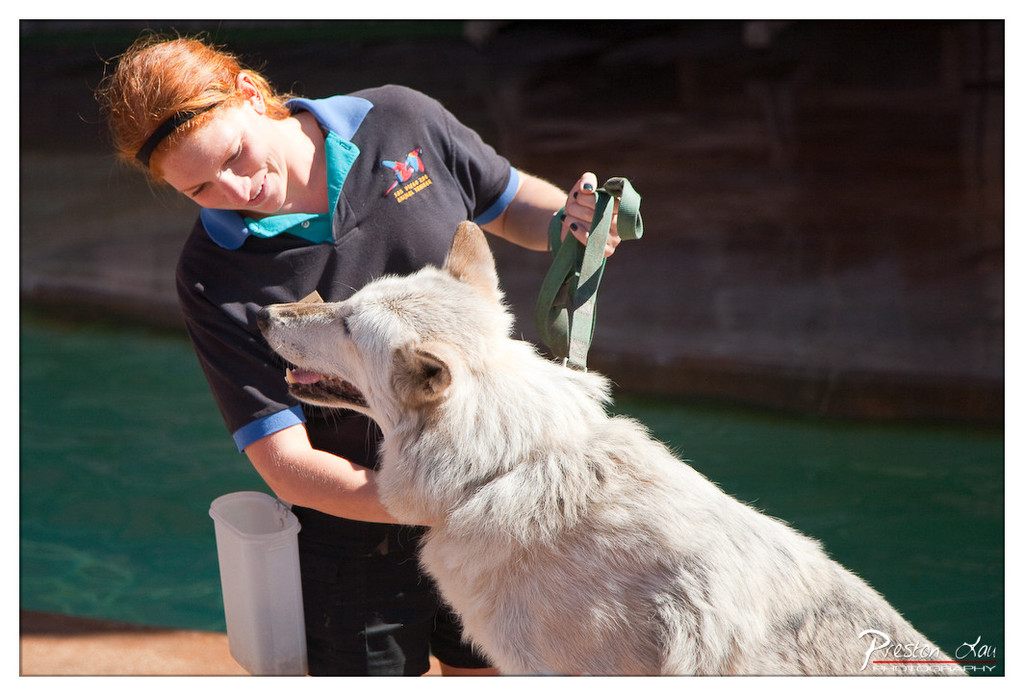

1. Overall Rating (0–10) — 7.0
This photograph captures a tender moment between a handler and a white wolf, conveying trust and connection with quiet intimacy. The warm sunlight highlights the soft texture of the wolf’s fur and the gentle expression on the woman’s face, creating a sense of warmth and authenticity. While the background remains slightly indistinct, the focus on the subjects enhances the emotional narrative, though a more deliberate composition could elevate the image’s visual impact.
2. Composition (0–10) — 6.5
The diagonal placement of the wolf and the handler creates dynamic movement, but the off-center framing and cropped background slightly disrupt visual balance. A tighter crop or repositioning might better emphasize the interaction.
3. Lighting (0–10) — 8.0
Strong, directional sunlight enhances texture and depth, casting soft shadows that define form and add dimension. The warm glow contributes to the image’s inviting mood.
4. Color & Tone (0–10) — 7.0
The contrast between the white fur and the cool green water creates a striking visual harmony, while the warm skin tones add emotional warmth. The color palette feels natural and cohesive.
5. Creativity (0–10) — 7.5
The image captures a compelling, unposed moment that feels both authentic and intimate. The choice to focus on the emotional bond rather than a staged display demonstrates thoughtful storytelling.
6. Technical Quality (0–10) — 8.0
Sharp focus on the subjects, clean detail in the fur and facial features, and well-managed exposure contribute to a high level of technical execution.
7. Emotional Impact (0–10) — 8.0
The connection between the handler and the wolf resonates deeply, evoking feelings of care, trust, and quiet companionship. The viewer is drawn into a moment of shared understanding.
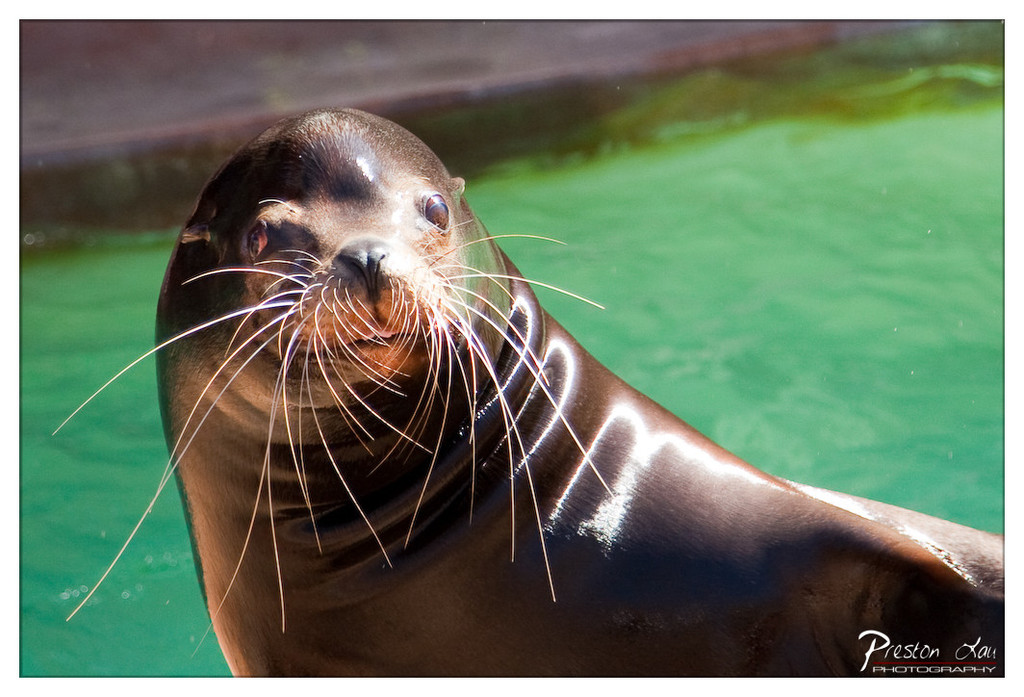

1. Overall Rating (0–10) — 8.0
This portrait of a sea lion captures an intimate, almost theatrical moment, where the subject’s curious gaze and prominent whiskers draw the viewer into its world. The vibrant green water provides a striking contrast to the sea lion’s dark, sleek fur, enhancing the image’s visual energy. While the lighting is strong and the focus precise, the composition’s slight imbalance keeps it from feeling fully resolved—still, it remains a compelling and emotionally engaging wildlife study.
2. Composition (0–10) — 7.0
The sea lion is placed slightly off-center, with its head occupying the left third of the frame, creating a dynamic but slightly asymmetrical balance. The diagonal flow of its body leads the eye toward the right, but the background lacks depth, slightly weakening the sense of space.
3. Lighting (0–10) — 8.0
Bright, direct sunlight highlights the sea lion’s wet fur, creating a glossy sheen and emphasizing texture. The light enhances the subject’s features, especially the delicate whiskers, which catch the sun like fine threads, adding a sense of life and movement.
4. Color & Tone (0–10) — 8.5
The rich emerald green of the water contrasts beautifully with the sea lion’s dark brown tones, creating a vivid, almost surreal palette. The color harmony is strong, with the warm tones of the fur complementing the cool background, and the vibrancy adds a lively, engaging quality.
5. Creativity (0–10) — 8.0
The photographer captures a rare moment of connection between the animal and the viewer, turning a simple wildlife photo into a character study. The emphasis on detail—especially the whiskers and eyes—gives the image a narrative quality, inviting curiosity about the sea lion’s thoughts and experiences.
6. Technical Quality (0–10) — 9.0
The image is sharp and well-focused, with excellent clarity in the sea lion’s facial features. The depth of field isolates the subject effectively, and the exposure is well-balanced, capturing fine detail without overexposing highlights.
7. Emotional Impact (0–10) — 8.5
The sea lion’s direct gaze and expressive eyes evoke a sense of intelligence and vulnerability, creating an immediate emotional bond. The viewer is drawn into the subject’s world, feeling a moment of quiet connection that lingers long after viewing.
Loading map...